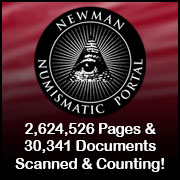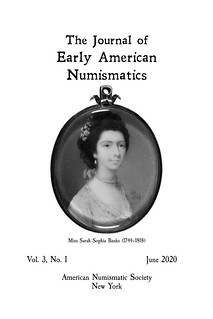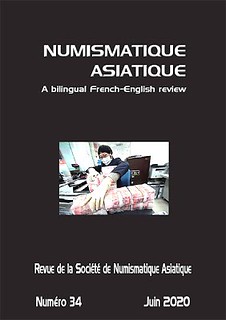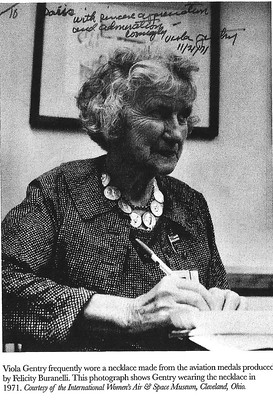
About UsThe Numismatic Bibliomania Society is a non-profit association devoted to the study and enjoyment of numismatic literature. For more information please see our web site at coinbooks.org SubscriptionsThose wishing to become new E-Sylum subscribers (or wishing to Unsubscribe) can go to the following web page link MembershipThere is a membership application available on the web site Membership Application To join, print the application and return it with your check to the address printed on the application. Print/Digital membership is $40 to addresses in the U.S., and $60 elsewhere. A digital-only membership is available for $25. For those without web access, write to: Charles Heck, Treasurer AsylumFor Asylum mailing address changes and other membership questions, contact Chuck at this email address: treasurer@coinbooks.org SubmissionsTo submit items for publication in The E-Sylum, write to the Editor at this address: whomren@gmail.com
BUY THE BOOK BEFORE THE COINSale Calendar
|
- WAYNE'S WORDS: THE E-SYLUM JULY 5, 2020
- THE D. BRENT POGUE NUMISMATIC LIBRARY
- NEW BOOK: PHILIPPINE MEDALS AND TOKENS, 3RD ED.
- NEW BOOK: A MARVEL TO BEHOLD
- NEW BOOK: NATIVE AMERICANS ON U.S. COINAGE
- NEW BOOK: PAPER MONEY OF THE GERMAN STATES
- JOURNAL OF EARLY AMERICAN NUMISMATICS JUNE 2020
- NUMISMATIQUE ASIATIQUE JUNE 2020
- ROMAN PROVINCIAL COINAGE VII.2 NOW ONLINE
- 2019 IBNS BOOK & LITERARY AWARDS
- NEWMAN PORTAL ADDS MONEY OF THE UNITED STATES
- VIDEO: DALTON GANG BANKNOTES
- HELP SAVE ROMAN IMPERIAL COIN COLLECTING
- FEIGENBAUM: JULY 2020 COIN MARKET OPTIMISM
- AMELIA EARHART MEDAL ARTIST BRENDA PUTNAM
- NOTES FROM E-SYLUM READERS: JULY 5, 2020
- QUERY: AYLESBURY ABOLITION OF SLAVERY TOKEN
- VOCABULARY TERMS: FIREGILDING, FIREGILT
- NELSON LEE SALTER (1874-1950)
- HARVEY STACK'S NUMISMATIC FAMILY, PART 73
- U.S. COIN DESIGNS: YESTERDAY, TODAY, TOMORROW??
- 2020 AMERICAN INNOVATION DOLLAR COIN DESIGNS
- NUMISMATIC NUGGETS: JULY 5, 2020
- GOLD AUREUS OF SEPTIMIUS SEVERUS
- GOLD COIN MAKING IN 10TH CENTURY MALI
- RARE SILVER PENNY OF A YORKSHIRE BARON
- PERATROVICH DOLLARS RELEASED IN ALASKA
- SOME VERY ODD DENOMINATION TOKENS
- COLLECTORS SEEK 2020 TENINO WOODEN SCRIP
- ON COLLECTING WOODEN MONEY
- LOOSE CHANGE: JULY 5, 2020
- FEATURED WEB SITE: SOUTH AFRICAN COINS
Click here to access the complete archive
Click here to unsubscribe (scroll down)
To comment or submit articles, reply to whomren@gmail.com
Content presented in The E-Sylum is not necessarily researched or independently fact-checked, and views expressed do not necessarily represent those of the Numismatic Bibliomania Society.
WAYNE'S WORDS: THE E-SYLUM JULY 5, 2020
 New subscribers this week include:
Paul Andreasen, Jon Ashelford, Petar II Blagojevic, Shane Bourke, Henk Budel, Jim Chambers, Helen Croghan, Robert Kamerling, Murtaza Karimjee, Lukas Koellner, Robert J Kurzatkowski,
Leszek Lewandowski, Tam Vo Minh, Julien Saunier, Shaun Smith, Leon Willis, Dennis Zammit,
New subscribers this week include:
Paul Andreasen, Jon Ashelford, Petar II Blagojevic, Shane Bourke, Henk Budel, Jim Chambers, Helen Croghan, Robert Kamerling, Murtaza Karimjee, Lukas Koellner, Robert J Kurzatkowski,
Leszek Lewandowski, Tam Vo Minh, Julien Saunier, Shaun Smith, Leon Willis, Dennis Zammit,
Many thanks to Owen Linzmayer of The Banknote Book for sending a number of these folks our way. Welcome aboard! We now have 6,139 subscribers.
Welcome also to new advertisers Kenny Sammut, Coleccionistas de Monedas, Rarepicks and African Collectible. Be sure to click on their ads and check out their website offerings. Also, the Coin Dealer Newsletter Monthly Greysheet is now a sponsor - click on their banner at the top of the issue for news. podcasts and subscription information on their site.
Thank you for reading The E-Sylum. If you enjoy it, please send me the email addresses of friends you think may enjoy it as well and I'll send them a subscription (but let me know if they are located in the European Union). Contact me at whomren@gmail.com anytime regarding your subscription, or questions, comments or suggestions about our content.
This week we open with a numismatic literature sale, four new books, two journals, an new online database, the IBNS book awards and updates from the Newman Numismatic Portal.
Other topics this week include Roman Imperial coinage, today's coin market, medallic artist Brenda Putnam, an abolition of slavery token, firegilding, past, present and potential future coin designs, a rare silver penny, the Peratrovich dollars, wooden money and South African numismatics.
To learn more about Philippine medals and tokens, native Americans on U.S. coinage, German states paper money, Miss Sarah Sophia Banks, coins in Yunnan, Travellers Cheques, Bunker Hunt's 35 million ounces of silver, the Gerber Variable Scale, Septimius Severus, the $1.20 token, the Randall Hoard, engraved gems and the Montreal Medal of Songose, read on. Have a great week, everyone!
Wayne Homren
Editor, The E-Sylum

THE D. BRENT POGUE NUMISMATIC LIBRARY
Stacks Bowers Galleries published this press release on their upcoming sale of the D. Brent Pogue Numismatic Library. -Editor
We are pleased to present the numismatic library of D. Brent Pogue in our August 2020 Public Auction Sale. While Brent Pogue did not focus on the library in the same manner as he did his magnificent coins and paper money, he was serious about acquiring important references and might well have assembled one of the great American libraries had he been able to continue the pursuit.
Numbering more than 100 lots, the books range from a handsome 17th-century work on medallic issues of 1500-1600 to volumes presented to him by Q. David Bowers over the years, many with personal inscriptions. In between these bookends will be found many important references, from important plated Chapman sales, to extremely rare items, such as one of five deluxe presentation copies of A.W. Browning on early quarters. Of particular note is a lot containing original Andrews, Maris and Chapman studies on the early large cents. Each is a great rarity in its own right, but will be presented as one lot, in a custom box, as assembled by Brent Pogue. Finally, perhaps too large to feature in a print advertisement but immensely historic nonetheless, is a beautifully matched leather bound set of The Numismatist, containing every issue from the rare original first six volumes (which once belonged to the first president of the ANA) through Volume 65 (1952).
The D. Brent Pogue Numismatic Library will lead off Session 3, beginning at 9:00 AM PT on Friday, August 7. For more information on the Pogue Library email John Pack at jpack@stacksbowers.com.
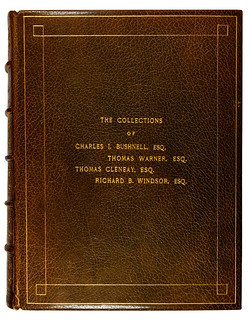
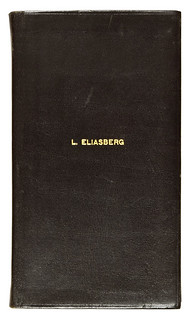
Magnificent leather bound volume containing the first four large-format Chapman sales, with plates. The Bushnell, Warner, Cleneay and Winsor sales.
Louis E. Eliasberg’s PersonalGreen’s Checklist. An incredible accounting of the formation of this famous American collection, in his own hand.
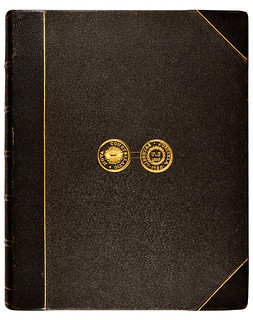
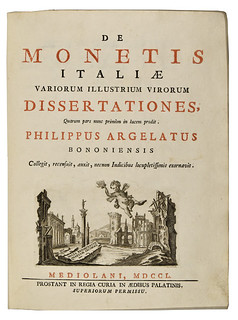
An Original Crosby with the Nova Constellatio Binding With provenance to the likely original owner, G.T. McCombe, circa 1881.
Rare Work on Italian Coinage by Filippo Argelati. The complete six volumes, published between 1750 and 1759, with extensive illustrations.
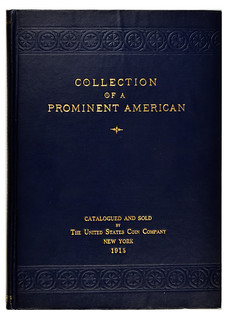
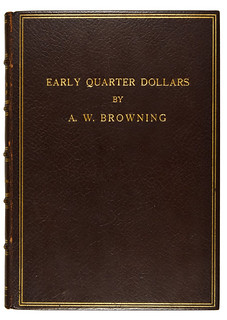
S.H. Chapman’s personal copy of the 1915 H.O. Granberg Sale. Hardbound, named and priced.
Extremely Rare Deluxe Leather A.W. Browning on Early Quarters. One of five such copies believed produced. With presentation inscription from Wayte Raymond to F.C.C. Boyd.
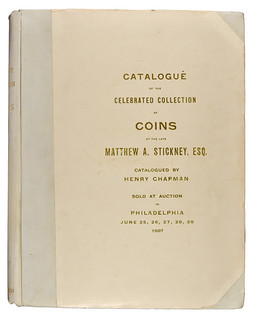
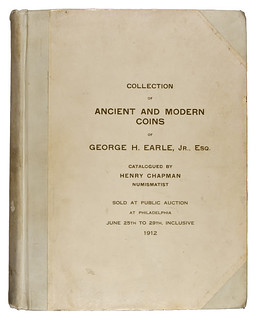
The Landmark 1907 Matthew Adams Stickney Collection Sale by Henry Chapman Hardbound with original plates.
The 1912 George H. Earle, Jr. Sale by Henry Chapman. A handsome and original hardbound copy with the 39 original plates.
To read the earlier E-Sylum article, see:
D. BRENT POGUE NUMISMATIC LIBRARY OFFERED
(https://www.coinbooks.org/v23/esylum_v23n25a02.html)

NEW BOOK: PHILIPPINE MEDALS AND TOKENS, 3RD ED.
Ray Czahor passed along word of a new edition of Earl Honeycutt’s book on Philippine tokens and medals. Thanks! -Editor
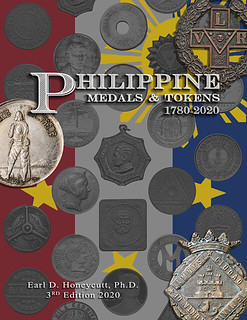 Just released this month!! Earl Honeycutt’s Philippine Medals and Tokens 1780-2020 3rd edition. Earl did yeoman's work on this edition which was greatly expanded with many more medal additions and page count going from 209 pages to 250 pages! Most Medals and Tokens are now in color! Descriptions of various medal compositions expanded with new discoveries. A number of gold medals have been added. The Token and Jeton sections have greatly improved. Special sections have been added: ‘Special Philippine Coins”, “Manila Carnival Collectibles’, “Major Philippine Medal Engravers’, and ‘Philippine Collectors Forum (PCF) Handouts’ (wooden nickels and coin slabs). This is the “BIBLE” for collectors now!
Just released this month!! Earl Honeycutt’s Philippine Medals and Tokens 1780-2020 3rd edition. Earl did yeoman's work on this edition which was greatly expanded with many more medal additions and page count going from 209 pages to 250 pages! Most Medals and Tokens are now in color! Descriptions of various medal compositions expanded with new discoveries. A number of gold medals have been added. The Token and Jeton sections have greatly improved. Special sections have been added: ‘Special Philippine Coins”, “Manila Carnival Collectibles’, “Major Philippine Medal Engravers’, and ‘Philippine Collectors Forum (PCF) Handouts’ (wooden nickels and coin slabs). This is the “BIBLE” for collectors now!
Cost will be $64 Postpaid within the United States by Media Mail. Shipments outside the US will require extra postage. (Weight is 2 lbs.) The 3rd edition can be ordered from the author: Earl Honeycutt, ehoneycutt@elon.edu or Ray Czahor, cookiejarpi@verizon.net.
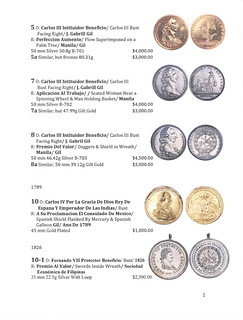
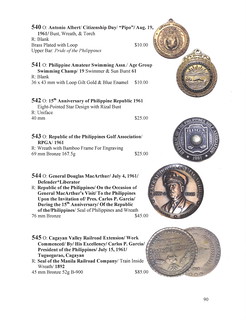
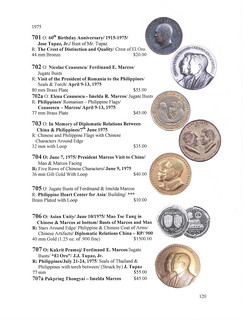
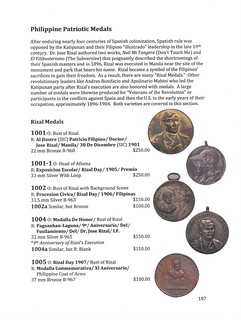
To read a review of the 1st edition, see:
BOOK REVIEW: PHILIPPINE MEDALS AND TOKENS, 1780-2010
(https://www.coinbooks.org/esylum_v17n17a07.html)
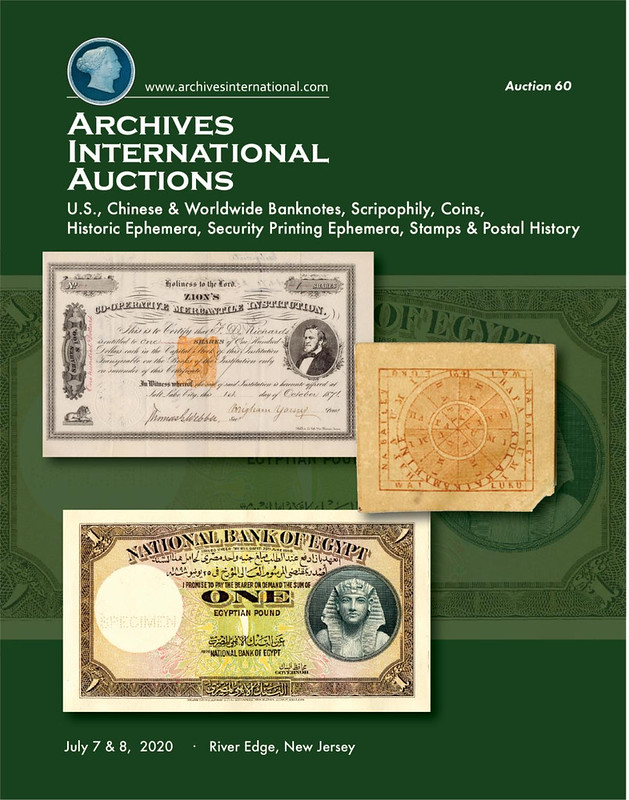
NEW BOOK: A MARVEL TO BEHOLD
Ted Banning writes:
"I just found out about this book that I thought might be of interest to E-Sylum readers. It's not actually numismatic, but focuses on Henry VIII's collecting of gold and silver more generally."
Thanks. Here's the write-up from the publisher's website. -Editor
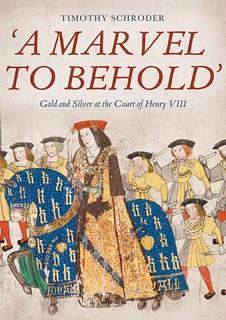 'A Marvel to Behold': Gold and Silver at the Court of Henry VIII
'A Marvel to Behold': Gold and Silver at the Court of Henry VIII
Timothy Schroder
Hardback
9781783275076
$80.00
June 2020
124 colour, 3 line illustrations
398 pages
24.4x17.2 cm
Bringing the existence and significance of the lost riches of Henry VIII back to life, this book sheds new light on Henrician and Tudor court culture.
Henry VIII amassed the most spectacular collection of gold and silver of any British monarch. Plate and jewels were hugely prominent in medieval and Renaissance courts and played an essential role in dynastic marriages and diplomacy as well as in cementing the bonds between king and court. Ranging from plain domestic wares to extraordinary bejewelled works of art, Henry's collection embraced virtuoso continental objects as well as vast quantities of plate commissioned from London goldsmiths or inherited from his father. But nearly all of these holdings were destroyed over the following century, and of the thousands that he owned no more than a handful have survived to modern times.
This book makes use of the wealth of surviving documentation - inventories, drawings, lists of payments, dispatches by foreign ambassadors and other records - to explore this lost collection and the light it sheds on the monarchy. Starting with an assessment of the young king's inheritance from his father, the book considers the role of plate at state banquets, in great church services and in the regular exchange of gifts between courtiers and ambassadors; the role of plate and jewels as a potent symbol of power; how the king used confiscation as an instrument of humiliation of those who fell from grace, including Cardinal Wolsey and Katherine of Aragon; and how Henry's avaricious seizure of church plate towards the end of his life throws light on his changing character. While the focus is on plate and goldsmiths' work, the context ranges from court ceremonial to rivalry between princes, the role of the church, the vulnerability of persons and institutions with covetable assets, and relations between the king and his own family.
Bringing the existence and significance of these lost riches back to life, the book sheds new light on Henrician and Tudor court culture.
TIMOTHY SCHRODER was Curator of Decorative Arts at the Los Angeles County Museum and a Consultant Curator at the Victoria and Albert Museum. Current or recent roles include Prime Warden of the Goldsmiths' Company, President of the Silver Society and a Trustee of the Wallace Collection. Publications include English Domestic Silver, The Gilbert Collection of Gold and Silver and British and Continental Gold and Silver in the Ashmolean Museum.
For more information, or to order, see:
'A Marvel to Behold': Gold and Silver at the Court of Henry VIII
(https://boydellandbrewer.com/imprints-affiliates/boydell-press/a-marvel-to-behold-gold-and-silver-at-the-court-of-henry-viii.html)
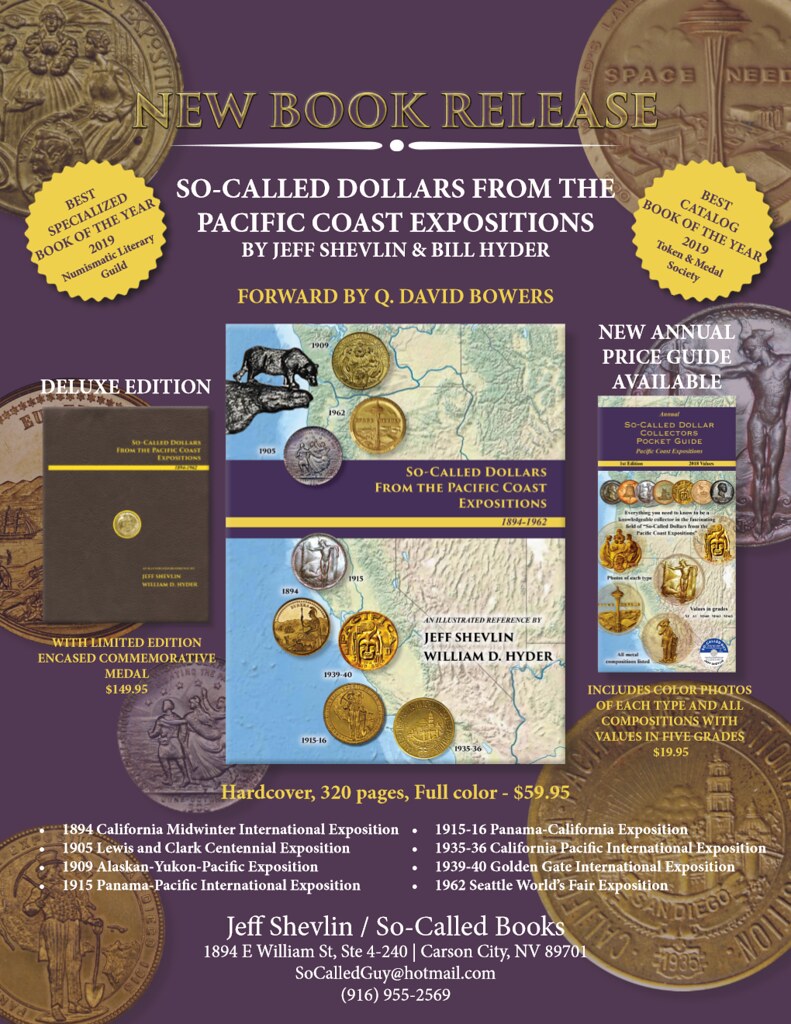
NEW BOOK: NATIVE AMERICANS ON U.S. COINAGE
This monograph isn't actually new (the 2nd edition was published in 2018), but it's new to me - I came across it while looking for other things this week. Here's a description from the Amazon site. -Editor
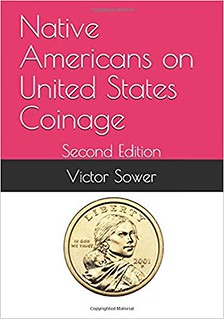 This book documents the depiction of Native Americans on United States coins. Some depictions are of actual Native American individuals, others represent a composite of known Native American individuals, while some are idealized or generalized images.Some of the coins are regular issues of the United States Mint intended primarily for circulation. These coins are usually included in uncirculated and proof editions by the Mint. Other coins are commemoratives or collectables which are issued only in uncirculated and/or mint editions. While these are also legal tender, their collection value exceeds their denominated value, and in some cases the “melt value” of the metal from which they were coined.
This book documents the depiction of Native Americans on United States coins. Some depictions are of actual Native American individuals, others represent a composite of known Native American individuals, while some are idealized or generalized images.Some of the coins are regular issues of the United States Mint intended primarily for circulation. These coins are usually included in uncirculated and proof editions by the Mint. Other coins are commemoratives or collectables which are issued only in uncirculated and/or mint editions. While these are also legal tender, their collection value exceeds their denominated value, and in some cases the “melt value” of the metal from which they were coined.
The book begins with the Regular Issues which depict actual Native American subjects. This section is followed by Regular Issues which depict idealized images of Native Americans. The next group, referred to as “imposters” represent depictions that appear to be Native American, but really are images of Liberty with an added feather headdress.The next section covers the commemorative half dollars followed by a section on the two collectable silver dollars depicting Native Americans. The final section covers the issues through 2018 in the Native American $1 Coin Program. These coins share a common obverse design depicting Sacagawea and her child but with a different reverse design each year.
Paperback: 37 pages
Publisher: Independently published (October 30, 2018)
Language: English
ISBN-10: 1729266797
ISBN-13: 978-1729266793
Product Dimensions: 7 x 0.1 x 10 inches
Price: $9.99
For more information, or to purchase, see:
Native Americans on United States Coinage: Second Edition
(https://www.amazon.com/Native-Americans-United-States-Coinage/dp/1729266797)
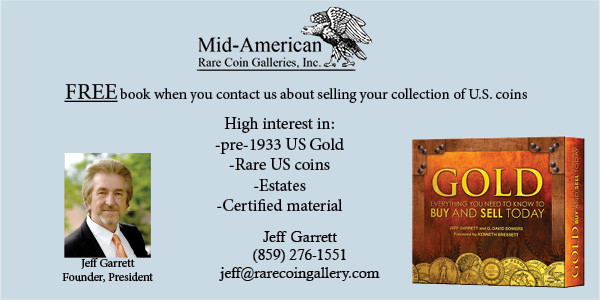
NEW BOOK: PAPER MONEY OF THE GERMAN STATES
A new book on the paper money of the old German states has been published in German by Battenberg Verlag. Here's a Google translation of the information from the publisher's website. Found via News & Notes from the Society of Paper Money Collectors (Volume VI, Number 1, June 23, 2020). -Editor
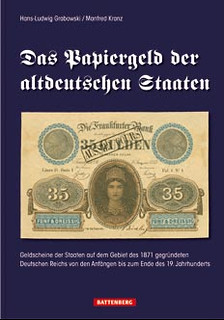 Hans-Ludwig Grabowski | Manfred Kranz
Hans-Ludwig Grabowski | Manfred Kranz
The paper money of the old German states
Banknotes of the German states of the German Empire founded in 1871 from the beginning to the end of the 19th century
Published by Battenberg Verlag
ISBN: 978-3-86646-188-8
Edition: 1st edition 2020
Illustrations: colored throughout
Hardcover: approx. 400 pages
Format: 17 x 24 cm
EUR 69.00
VAT included.
available soon (July 2020)
The Taler and Guldenscheine of the German states of the German Reich founded in 1871 are among the most interesting and rarest German banknotes ever. For the first time, all of the issues from the beginning to the end of the 19th century are listed in the completely colored catalog, arranged according to historical countries, provinces and regions. The expenditures of the central banks, state coffers, registry office and state and local emergency money and those under French occupation are not separated from each other, but summarized among the individual states, which ensures better traceability. With concordances to the A numbers at Pick / Rixen and to the standard catalogs "World Paper Money".
For more information, or to order, see:
Das Papiergeld der altdeutschen Staaten
(https://www.battenberg-gietl.de/sammeln/buch/das-papiergeld-der-altdeutschen-staaten)

JOURNAL OF EARLY AMERICAN NUMISMATICS JUNE 2020
The latest issue of JEAN, the Journal of Early American Numismatics has been published by the American Numismatic Society. Here is the table of contents and an excerpt from the Editor’s Preface by Christopher R. McDowell. This issue features a very important article by Jeff Rock on the collection of Miss Sarah Sophia Banks at the British Museum. -Editor
Editor’s Preface
Collecting American Colonial Coins in Eighteenth-Century England
Jeff Rock
Regulator and Regulated: The Monetary Conditions of Goldsmith
Thomas Shields and the Successful Circulation of Foreign Gold Coinage
Jesse C. Kraft
Proposed Design of a Commemorative Medal of the Battle of Pensacola (1781) by the Royal Academy of San Carlos Mexico
Ángel O. Navarro Zayas
Aztec Influence in Early Spanish Colonial Four-Reales Coinage, 1538–1542
Philip C. Ellsworth
The Montreal Medal of Songose: A Case Study of Established Numismatic Lore
Julia H. Casey
[I]t is the beautiful young woman on the cover who began acquiring what is arguably the most important intact coin collection ever assembled by a private individual. Her collection, as you will learn, is not only important for its holdings of British treasures, but also its American colonial pieces. Before today, few Americans had the pleasure of seeing Miss Banks’ American coins, but here they are for our subscribers to enjoy along with Jeff Rock’s brilliant descriptions and analysis.
Jeff ’s article has been in the works for a long time. The American Numismatic Society, through JEAN’s publisher, Andrew Reinhard, worked with the British Museum for over a year in order to bring you the fantastic images of Miss Banks’ collection in this issue. Jeff traveled to England at his own expense, and spent time at both museums where he tracked down, selected, and examined all the coins presented here. Many of the coins you will see in his article have never before been photographed or studied by American numismatists. I wish to thank the ANS, Andrew, and Jeff for their efforts and financial commitment in helping to bring this important article to our subscribers.
Miss Sarah Sophia Banks, as you shall learn, was not a hoarder, but an astute, sophisticated collector—she collected with a purpose, she was not merely acquiring stuff. And, like many of you, she clearly enjoyed spending her leisure time with her collection, lovingly organizing and recording every specimen. Thus, her existing notes (some are missing) provide us with a rare opportunity to learn how a late eighteenth and early nineteenth-century collection of American colonial coins was put together in Europe. Through Jeff ’s research we learn which American coins were available, how much they cost, and who was selling, trading, or giving them away.
In many instances, the only reason mint state or near mint state specimens of some American coins have survived is because people like Miss Banks saved them for us. Jeff does an excellent job in explaining how English collectors helped preserve American colonial coins. While Jeff discusses several other collectors and writers, the star of the show is Miss Banks. Jeff ’s article takes up the bulk of this edition of JEAN, but it is by no means the only thing readers have to look forward to in this issue!
Dr. Jesse Kraft takes a look at Philadelphia goldsmith Thomas Shields’ business records to inform us on gold coin regulating. With much hubris, Ye Editor thought he knew pretty much all there was to know about pre-Revolutionary gold coin regulation—I am now somewhat humbled. There was far more to the gold coin regulating business than even I (with my vivid imagination) could have ever dreamed of. I thought the business consisted mostly of plugging gold coins to raise their weight, and was totally unaware that the bulk of the work was doing just the opposite. Who knew that regulators spent more time and made more money shaving gold coins than plugging them? Business ledgers like those of Mr. Shields are a treasure trove of information that are beginning to open our eyes to the rich history of the coins we collect and study. I would be remiss if I did not add that Dr. Kraft is the new assistant curator of American numismatics at the ANS. I wish him well in this job, and I am sure all our subscribers do as well. Although this is his first article in JEAN, I do not think it will be his last.
I am currently working on a book to update C. Wyllys Betts’ work on American colonial medals. As I slowly slog my way through each medal, I have come to appreciate Spain’s tradition of proclamation and commemorative medals relating to the Americas. Some of the medals listed by Betts were never produced. This issue of JEAN presents an article dealing with an unlisted Betts medal; one that was never actually minted—the proposed medal commemorating the battle of Pensacola, in British West Florida. This proposed piece memorializes an event not taught in schools, viz. the successful Spanish attack on Pensacola during the American Revolution. This article was prepared by Dr. Ángel O. Navarro Zayas from Ponce, Puerto Rico. I am informed by several sources that he is the numismatic expert on that island. As a native speaker of Spanish, his perspective on Spain’s American numismatic tradition is invaluable. This is the second issue in a row where he has shared something with us, and I hope he will continue that trend.
We are also lucky to have another article on Spanish coinage in this issue. This article, written by a new contributor, Philip Ellsworth, was a real treat for me and the other editors. We all loved it. One of our points of emphases over the last two years at JEAN has been to explore Spanish coinage in greater depth. Mr. Ellsworth’s article is about as deep a dive as you can take; a thrilling adventure into pre-Columbian Aztec influence on Spanish coinage. As it turns out, one year the prepared dies for the Mexico City mint did not arrive from Spain, and the mint turned to local Aztec workers to help fashion the new dies. The resulting coins from this clash of cultures are fascinating! I am sure you will enjoy reading and learning about this unique moment in history as much as we have.
I save the article from my friend Julia Casey for last. Julia has been a phenomenal addition to JEAN’s editorial team. As every author can attest, she has made everything published in these pages better. Her research skills are unsurpassed. Coincidentally, Julia is from a small town in New York State called Ballston Spa that has a wonderful numismatic story attached to it; the discovery of a Montreal Medal, Betts-431, issued to a Native American warrior from the Mohican Tribe known only as Songose. This specific medal has been studied and written about by many fine numismatic scholars. Julia shows us that there is more to the story, and in doing so makes the point that we should not just assume we know everything there is to know about colonial coins and medals. Each coin and each medal has a rich history that we have only just started to understand.
For more information on the American Numismatic Society, see:
http://numismatics.org/
For more information on the Journal of Early American Numismatics, see:
Journal of Early American Numismatics (was Colonial Newsletter)
(http://numismatics.org/store/cnl/)
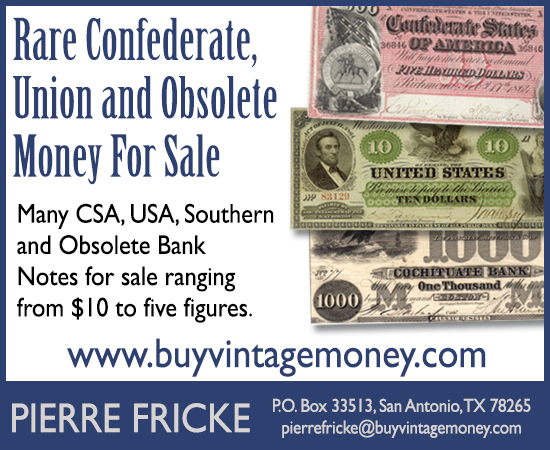
NUMISMATIQUE ASIATIQUE JUNE 2020
Here are the contents of the latest issue of Numismatique Asiatique. -Editor
Asian coins opposite the Covid-19
Asian currencies in French public collections
SECOND PART
CAMBODIA
The Adhémard Leclère (1853-1917) numismatic collection at the Musée d'Alençon
by Alain Escabasse
INDIAN OCEAN
The spread of the rupee in French possessions in the Indian Ocean
by Daniel Cariou
Some medals relating to the Far East
CAMBODIA
Note on the medal struck by the Monnaie de Paris on the occasion of the visit of King Sisowath, July 13, 1906
by Olivier de Bernon
COCHINCHINE
The agricultural and industrial exhibitions of Saigon in 1866 and 1867
by Daniel Cariou
LAOS
The Haut-Laos Committee and its medals
by François Joyaux
CHINA
Copper and coins in Yunnan around 1867-1868
by Francis Garnier
ERRATA
Annam imperial coins
"Asian coins" series
For more information, see:
https://sites.google.com/site/societedenumismatiqueasiatique/revue
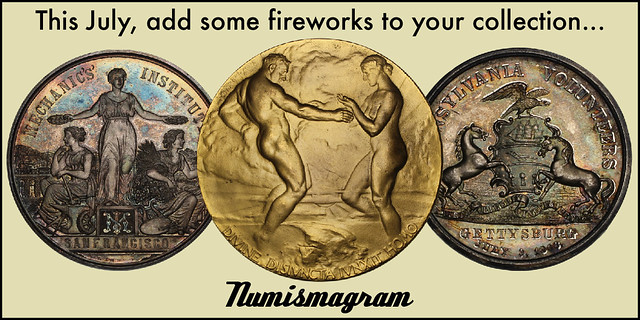
ROMAN PROVINCIAL COINAGE VII.2 NOW ONLINE
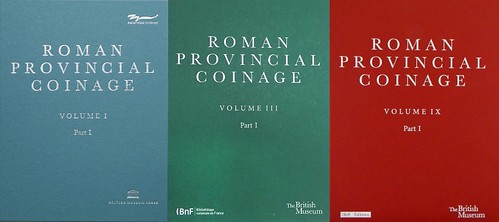
Mark Fox writes:
"The preliminary version of Roman Provincial Coinage VII.2 was announced on July 1 as having been put online"
Thanks. Here's the announcement with links to the website. -Editor
RPC volume VII.2 is now online! It covers all Roman provincial coinages issued in the reigns of Gordian I, Gordian II, Balbinus, Pupienus, and Gordian III (AD 238–244). It includes over 3,600 type descriptions and more than 24,000 coins, issued by 128 cities. The geographical scope ranges from Dacia to Egypt, without the province of Asia which was previously published in RPC VII.1 (in 2006). Jerome Mairat (Oxford) and Marguerite Spoerri (Oxford) are the main authors and editors of this volume, with contributions by Michel Amandry (Paris), Roger Bland (Cambridge), Kevin Butcher (Warwick), Jack Nurpetlian (Beirut), and Ulrike Peter (Berlin). Corrections and additions will be incorporated in the printed volume planned for next year. Please submit feedback through RPC online.
Browse at:
https://rpc.ashmus.ox.ac.uk/coins/7.2
Browse using the map at:
https://rpc.ashmus.ox.ac.uk/search/map?volume_id=14
Here's an overview of this monumental project. -Editor
The Roman Provincial Coinage project embodies a new conception of Roman coinage. It presents for the first time an authoritative account of the coins minted in the provinces of the empire and shows how they can be regarded as an integral part of the coinage minted under the Roman emperors.
The aim of the project is to produce a standard typology of the provincial coinage of the Roman Empire. This represents the first systematic treatment of the civic coinage at the height of the Roman empire. The material presented is an invaluable source of information for imperial portraiture and titulature, the response of the cities to the establishment of a new political order under the Roman empire, the way the government controlled the provinces, the internal history of the cities, and the role of the provincial coinage in the economy of the Roman empire as a whole. It will thus not only meet the needs of numismatists but will also be an essential reference book for historians, epigraphists, archaeologists and other students of the Roman empire.
The publication of Roman Provincial Coinage volume I (44 BC–AD 69) in 1992 marked the start of this international initiative, which will comprise ten volumes in all. Roman Provincial Coinage is published by British Museum Press and the Bibliothèque Nationale de France, and the online publication is based in the Ashmolean Museum, University of Oxford.
To read the complete announcement, see:
https://www.facebook.com/RPCproject/posts/2876115125849661
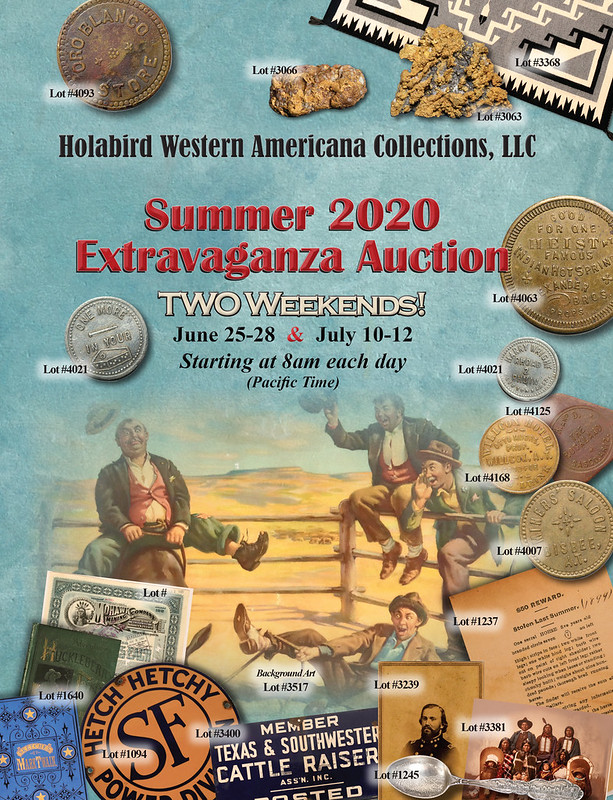
2019 IBNS BOOK & LITERARY AWARDS
Here are the winners of the 2019 International Bank Note Society Book & Literary Awards. Congratulations to all! Many thanks to Ken Berger for assistance finding book images. -Editor
Presented by Dennis Lutz and Joel Shafer
BOOK OF THE YEAR AWARD 2019
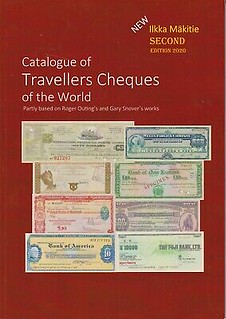
1. Catalogue of Travellers Cheques of the World (1st Ed.) — Ilkka Makitie, Stadio Ltd, Finland (2019) AND Catalogue of Circular Notes and Circular Letters of Credit (2" Ed.) — Ilkkakitie, Stadio Ltd, Finland (2019)
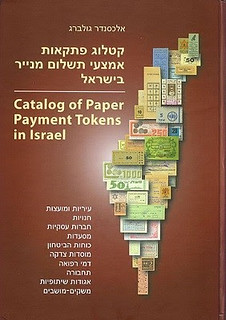
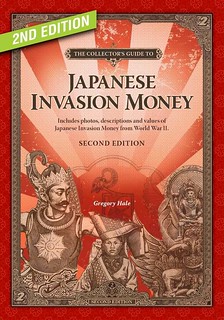
2. Catalog of Paper Payment Tokens in Israel — Alexander Golberg, Israel (2019)
3. The Collector's Guide to Japanese Invasion Money (Second Edition) — Gregory Hale, Centaur Media, Australia (2019)
Honorable Mention: (alphabetical order)
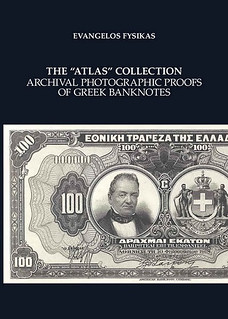
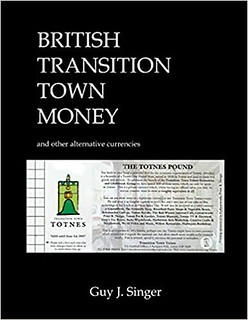
The "Atlas" Collection - Archival Photographic Proofs of Greek Banknotes — Evangelos Fysikas, A. Karamitsos, Greece (2019)
The Avraham Barnea Collection of Libyan Banknotes — Avraham Barnea and Yigal Arkin, (2019)
British Transition Town Money (and other alternative currencies) — Guy J. Singer, United Kingdom (2019)
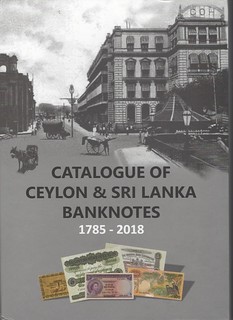
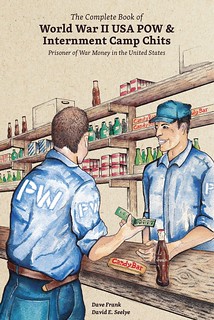
Catalogue of Ceylon and Sri Lanka BankNotes 1785-2018 — Dr. Kavan Ratnatunga, Wasim Sattar Bhoja, Burlington Numismatics (2019)
The Complete Book of World War II USA POW & Internment Camp Chits Prisoner of War Money in the United States — David H. Frank and David E. Seelye, U.S.A. (2019)
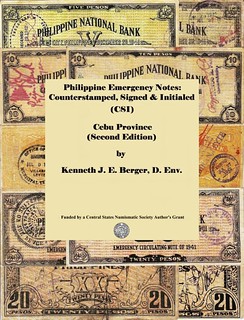
Philippine Emergency Notes: Counterstamped, Signed & Initialed (CSI) Cebu Province (2nd ed.), Kenneth J. E. Berger, D. Env., San Diego, CA, U.S.A. (2019)
2019 IBNS JOURNAL ARTICLES: FRED PHILIPSON AWARD
1. Michael H. Ryan, "Canadian Banknotes for the British West Indies, 1900-1950" (Vol. 58, #1)
2. Lyudmila Pryazhnikova and Maria Klysh, InterCrim-press, "The Integration of New Security Features on Banknotes: A Survey" (Vol. 58, #3)
3. Rezwan Razack, "Portrait Notes of Queen Victoria for India" (Vol. 58, #3)
Honorable Mention: (alphabetical order)
Jan Olav Aamlid, "The Approved, Never Issued, 100 Baht Note" (Vol. 58, #4)
Gordon de Totth, "People on Australian Banknotes with Suburbs in Canberra Named After Them" (Vol. 58, #3)
Evangelos Fysikas, "1943-1945: Local Italian Bank Check and Notes in the Greek Dodecanese Islands" (Vol. 58, #4)
Tim Lawes, "British Treasury First issue Pound Notes August 1914 — A Detailed Analysis" (Vol. 58, #1)
David B. Lok, "The Boom and Bust of Green Gold in Mexico's Yucatan" (Vol. 58, #4)
WARD D. SMITH AWARD (Best article related to Chinese banknotes)
Roger Urce, "The Japanese Occupation & Administration of Taiwan" (Vol. 58, #1)
2020 AMON G. CARTER, JR. EXHIBIT AWARD
Not awarded due to Coronavirus IPMS cancellation
For more information on the International Bank Note Society, see:
https://www.theibns.org/
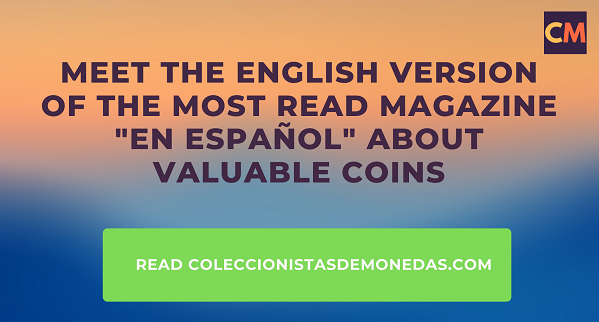
NEWMAN PORTAL ADDS MONEY OF THE UNITED STATES
The latest addition to the Newman Numismatic Portal is Money of the United States, a scarce 1942 guide to the Mint and BEP. Project Coordinator Len Augsburger provided the following report. -Editor
Newman Portal Adds Money of the United States
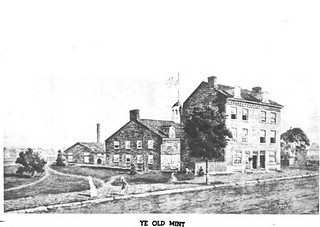 While our scanning machines are inactive due to the epidemic, Newman Portal continues to build a curated numismatic library from various electronic sources. A recent addition is Money of the United States (1942), a 31-page overview of the Mint and Bureau of Engraving and Printing, published by the Washington Service Bureau. The work is clearly compiled from secondary sources and includes a reproduction of Edwin Lamasure’s iconic image of the first United States Mint, here presented as “Ye Old Mint.”
While our scanning machines are inactive due to the epidemic, Newman Portal continues to build a curated numismatic library from various electronic sources. A recent addition is Money of the United States (1942), a 31-page overview of the Mint and Bureau of Engraving and Printing, published by the Washington Service Bureau. The work is clearly compiled from secondary sources and includes a reproduction of Edwin Lamasure’s iconic image of the first United States Mint, here presented as “Ye Old Mint.”
A Google search locates a description of the Bureau in May 1918, noting its charter “...to direct the thousands of persons who arrive daily in Washington... to get to the proper Government department. The bureau will also give information concerning Government activities...” The “information” apparently included publications providing overviews of various government operations, in this case the Mint and Bureau of Engraving and Printing. If this is the case, this publication acted as somewhat of a visitor’s guide, similar to the popular Evans guides sold by the thousands to Mint visitors in the late 19th century.
Link to Money of the United States on Newman Portal:
https://nnp.wustl.edu/library/book/585633
VIDEO: DALTON GANG BANKNOTES
These are selections from the David Lisot Video Library that feature news and personalities from the world of coin collecting. David has been attending coin conventions since 1972 and began videotaping in 1985. The Newman Numismatic Portal now lists all David’s videos on their website at:
https://nnp.wustl.edu/library/multimediadetail/522852
Here's one on banknotes stolen by the notorious Dalton gang. From the 2018 International Paper Money Show. -Editor
Notorious Dalton Gang and the Banknotes They Robbed
Steven Carr, Researcher, David Lisot, Video Producer, CoinTelevision.com.
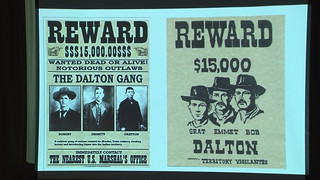 The Daltons were three brothers who were an unsavory lot who robbed banks in the 1890’s in Kansas. They wanted their exploits to rival their hero Jesse James resulting in some outrageous crimes. Hear this well-researched presentation from researcher Steve Carr complete with pictures from the time period and banknotes they could have robbed.
The Daltons were three brothers who were an unsavory lot who robbed banks in the 1890’s in Kansas. They wanted their exploits to rival their hero Jesse James resulting in some outrageous crimes. Hear this well-researched presentation from researcher Steve Carr complete with pictures from the time period and banknotes they could have robbed.
An excerpt of the video is available for viewing on the Coin Television YouTube Channel at:
https://youtu.be/U0j0QPywaww
THE BOOK BAZARRE
HELP SAVE ROMAN IMPERIAL COIN COLLECTING
Mark Fox passed along this bulletin from Classical Numismatics Group about a new threat to the ancient coin collecting hobby in the U.S. This is an urgent matter with a comment deadline of July 8, 2020. -Editor

Once again, our hobby is being threatened by potential new restrictions on the import of ancient coins. This time, two of most popular of all ancient types, Roman Republican and Roman Imperial coins, are in the cross-hairs. It is reportedly being proposed that import restrictions on all Roman coins be added to the current Memorandum of Understanding (MOU) between the United States and Italy as it comes up for renewal this year.
To protect the pursuit we all love, Classical Numismatic Group is asking our collector friends and colleagues to send comments to the US State Department opposing any restrictions on the importation of Greek and Roman coins that were produced in Italy. The deadline for comments is July 8.
In the past few years, collectors have gained some important exemptions for certain coin types via lobbying the State Department’s Cultural Property Advisory Committee (CPAC). While the record is mixed and some restrictions have been imposed, until now both later Roman Republican issues (after 211 BC) and Roman Imperial coins have not been subject to restrictions.
This government regulation or MOU is up for renewal every five years. Since 2011 when this restriction first applied to ancient coins, it has covered Greek coins produced in Italy as well as the earliest Roman coins, pre-211 BC. This time, certain segments of American archaeological associations and a powerful lobbying organization that seeks to ban all private collecting of ancient artifacts will likely push for the extension of restrictions to all Roman coins.
This would greatly reduce the number of coins that could enter and make importation from overseas venues either illegal or vastly more difficult and time consuming. This, along with the additional costs of importation to include required documentation, would likely lead to increased prices.
While many of the most expensive coins do have pedigrees, there are many coins entering the market that do not have an extensive paper trail. While we have learned to live with restrictions on certain types of ancient coins by researching pedigrees, this has curtailed the trade among these types and resulted in increased prices that have limited the collector base and the general enjoyment of an age-old hobby.
Comments should be polite, succinct and to-the-point. They should request that the current restriction on coins produced in Italy be removed, as coins by their nature are intended to circulate widely, in many cases far beyond the borders of Italy or even the Roman Empire. The current nation-state of Italy did not exist until 1861, therefor Italy should have no claim on coins produced thousands of years in the past. It is important to stress that, even if the current restrictions remain, under no conditions should they be extended to all Roman coins.
For further information including suggested comments, see Please Help Save Roman Imperial Coin Collecting by Peter Tompa, a cultural property attorney who has made it his life’s work to stand against arbitrary import restrictions.
Comments may be submitted to the Cultural Property Advisory Committee. Please click the blue button at the top right to be directed to the comment page. Please note that your comments are not private and may be included on the government public comment page. The deadline to submit a comment is July 8.
Click here to submit a comment .
Thank you for your attention to this important matter! Please feel free to contact CNG with any questions.
To more information, read Peter Tompa's post: Please Help Save Roman Imperial Coin Collecting
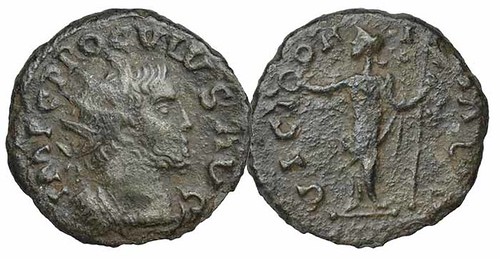
Mark adds:
"And here I thought the proposed MoU between Turkey and the US was pretty disheartening. This one, if the rumors are correct and the new restrictions are approved, would effectively mean every ancient coin struck in the Western world could conceivably be stopped by US customs and/or subject to confiscation since it would be too confusing anymore to decide which types are restricted and which aren't, without proper documentation."
In her July 4, 2020 email newsletter, Shanna Schmidt also discussed the urgency of fighting this MOU. -Editor
Memorandum of Understanding with Italy (renewal and addition)
Most collectors are aware that the U.S. holds agreements called Memorandum of Understanding (or MOUs) with several countries. These agreements were put in place to protect cultural property and ultimately stop looting of archaeological sites. Of course in theory this all sounds perfectly logical. Who of us wants to see looting of sites and destruction or a rise in black market sales of cultural property. The worst period was when the coin and antiquity industry was suggested to be linked to terrorism. The fact is that most of what is reported on site destruction and cultural property has very little to do with supporting terrorist organizations. The protection of cultural sites is very important to me, as is to other dealers in our trade.
There is however a deep and unfortunate disagreement on what defines cultural property. Should ubiquitous coins of which hundreds of thousands exist be placed under the same protection as say a rare Greek vase? Do countries like the U.K. have it right with programs like the Treasure Act and the Portable Antiquities Scheme where metal detectorists are not vilified but actually help contribute to the recording of hoards? There are a lot of different viewpoints and I am not here to judge either side. Obviously as a dealer of rare coins I would like to see fairer agreements and some degree of open trade. I would like to see hoards recorded as they were in the past before people got scared and just absconded with material through the black market.
The U.S. started it’s agreement with Italy in 2001 but it was without the inclusion of coins. This came much later in 2011 and included Greek, early Republican and provincial imperial coinage. The MOU is set to renew this month and the intention is now to add Roman Imperial coinage into the agreement. This would create even more restrictions on U.S. collectors, something that is not extended to many European countries.
It is imperative that people voice their opposition to this extension of the MOU and the addition of Roman Imperial coins. Here is a link to cultural property attorney Peter Tompa’s blog and the link to the State Department website where you can send your note. Please consider doing this if you care about collecting.
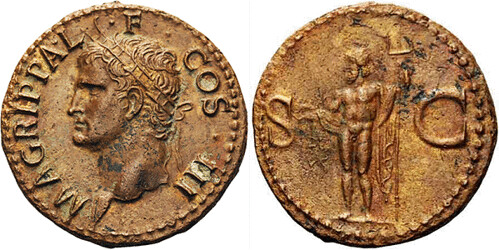
To more information, read Peter Tompa's post: Please Help Save Roman Imperial Coin Collecting

FEIGENBAUM: JULY 2020 COIN MARKET OPTIMISM
Coin Dealer Newsletter publisher John Feigenbaum penned the following article for the July 2020 Greysheet, and it's a great summary of the current state of the coin market. With permission, we're republishing it here. -Editor
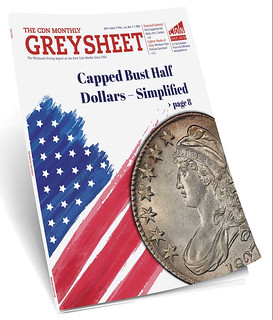 Allow me, if I may, to strike a tone of optimism here. For the first time this year, we are starting to feel some of the weight lifted from our collective shoulders. I speak from a coin dealer’s perspective, of course, however, many small businesses the world over are experiencing the beginnings of the sun poking through the clouds.
Allow me, if I may, to strike a tone of optimism here. For the first time this year, we are starting to feel some of the weight lifted from our collective shoulders. I speak from a coin dealer’s perspective, of course, however, many small businesses the world over are experiencing the beginnings of the sun poking through the clouds.
After months of lockdown, is it safe to say we are we in recovery mode? Maybe yes, maybe no. However, here in the Commonwealth (we don’t call it a state for some reason) of Virginia the governor has opened the economy to “Phase 2” (limited indoor restaurant seating, gyms, swimming pools, beaches, etc) with Phase 3 in sight. That, in itself, is encouraging enough to get me out of bed in the morning. I’m so excited to actually get a real cup of Starbucks in the morning. I always appreciated it, but now I don’t take it for granted!
We have written in these pages over the past few months that the numismatic market was incredibly resilient during the initial scares of COVID. Hobbies like coin collecting were largely beneficiaries of people’s extra time during the darkest months of the pandemic. Heck, even the Wall Street Journal posted an article on Friday, June 5 titled, “Why Stamp Collecting Is Back in Vogue.” Say what?? (Disclaimer, I am a lifelong stamp collector and I’m not looking for more competition in auctions.)
As we emerge from the lockdown it is clear that the coin business may look somewhat different than when we last witnessed a public event, way, way, back in February. So many coin shows were forced to cancel that I personally re-coded our web site to change “Coin Show Calendar” to “Events Calendar” and allow for auction (live and otherwise) as well as Internet-only events. I was already planning to do this but the future arrived a few years sooner than I imagined.
Among the canceled shows, there appears to be some internal turmoil. Central States Numismatic Society not only canceled their seminal March event but also discontinued their decades-long relationship with show promoter Kevin Foley, and his daughter Patricia. As I write, the ANA is still grappling with their decision to go forward—or not—with the World’s Fair of Money in August. So far the city of Pittsburgh hasn’t made any formal decisions about events and the non-profit organization stands to lose quite a bit of money if they cancel without legal cause. If they do hold the show, will anyone come???
Meanwhile the live auction companies of Heritage and Stack’s Bowers have continued to hold their live auctions—traditionally in conjunction with major shows—back at their offices without any noticeable backlash or degradation of prices realized. Don’t for a second think their controllers haven’t noticed.
I am told by numerous contacts that the biggest hangover going into the late Summer months will be a lack of fresh inventory. Retailers, auction houses and grading firms alike are experiencing the lagging indicator of fresh material entering the market. Collectors are more engaged than ever, which means they’re not inclined to sell. And wholesale business without coin shows is much less efficient.
So, what does this portend? Higher prices! After several years of sliding valuations, I am extremely optimistic that prices at auction and bids on CDN Exchange will start rising. If you’ve been thinking of selling, you will find the companies running ads in this magazine extremely friendly right now. They all tell me they need fresh material. As Patrick Ian Perez reports in his “Activity Across the Market” column, one major retailer has been aggressively seeking uncirculated rolls to fill orders. (We’ve been waiting since the 1960’s for this news!) Franklin and Kennedy halves are super-hot sellers on TV and dealers are bidding these up as well.
It won’t take much to put some real air in this balloon. Pretty soon we will get back to live auctions with real live coin shows and I predict we will all be happier than ever when we see one another. The coin community has been my family for over 35 years and I miss you all!
To read the complete article, see:
Publishers Message (July 2020 Greysheet)
(https://www.greysheet.com/news/story?title=publishers-message-july-2020-greysheet)
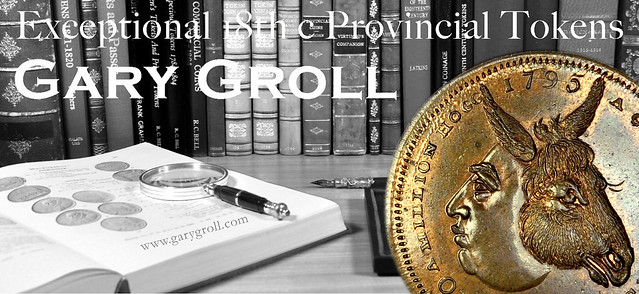
AMELIA EARHART MEDAL ARTIST BRENDA PUTNAM
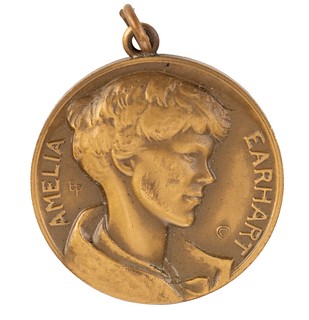
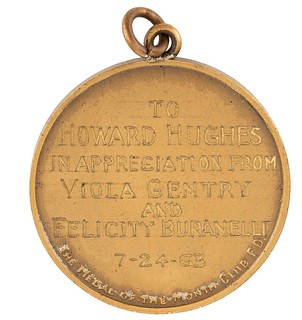
Last week we published an auction lot description for Howard Hughes' personal Amelia Earhart medal "presented by aviator Viola Gentry and artist Felicity Buranelli". Researcher Harry Waterson wrote about this medal in his 2012 book THE MEDAL-OF-THE-MONTH CLUB Created by Felicity Buranelli. -Editor
"Miss Felicity Buranelli was the creator and promoter of the series. But she was not the sculptor. The Earhart medal was done by Brenda Putnam. I have always thought she caught a great profile of Earhart. I love this medal.
Attached is a lovely photograph of Viola Gentry wearing a necklace made up of at least 8 of the medals of the MOTMC series."
Harry's source for the picture is the book North Carolina Aviatrix, Viola Gentry, The Flying Cashier by Jennifer Bean Bower, The History Press, Charleston, SC 2015 (p159). -Editor
Harry adds:
"On checking the date on the Earhart medal to Hughes, 7/24/1963 was the day Earhart would have turned 66. On that date in her home town of Atchison, KS the US Post Office issued the 8-cent Amelia Earhart Airmail stamp. Viola Gentry was greatly involved in the efforts to promote the stamp. How Howard Hughes might have been involved with this I don't know, but the date on the medal makes one wonder."
To read the earlier E-Sylum articles, see:
NEW BOOK: THE MEDAL-OF-THE-MONTH CLUB
(https://www.coinbooks.org/esylum_v15n26a02.html)
HOWARD HUGHES MEDALS OFFERED
(https://www.coinbooks.org/v23/esylum_v23n26a24.html)

NOTES FROM E-SYLUM READERS: JULY 5, 2020
More on Classic Gold Coins of 1834 -1839
 Regarding Daryl Haynor's new book on U.S. Classic Gold Coins of 1834 -1839,
Dale Walther writes:
Regarding Daryl Haynor's new book on U.S. Classic Gold Coins of 1834 -1839,
Dale Walther writes:
"Nice introduction by Q.David Bowers and interesting to read the stories of both contributors that led to their interest in the Classic Gold Coins of 1834-1839. Lots of welcome history is also included relating to the time period as well. For those who relish coins as a way to connect with our nation's own history this is an enticing read as to the subject time period. These "monuments" from the past become meaningful to the reader thanks to the incredible scholarly presentation by the current author who incorporated the efforts of his mentor consequent from their combined decades of research and study."
Thanks! The book is selling fast, so see the earlier articles for purchasing information. -Editor
To read the earlier E-Sylum articles, see:
NEW BOOK: U.S. CLASSIC GOLD COINS OF 1834-1839
(https://www.coinbooks.org/v23/esylum_v23n12a02.html)
BOOK REVIEW: U.S. CLASSIC GOLD COINS OF 1834-1839
(https://www.coinbooks.org/v23/esylum_v23n26a07.html)
On the Carnegie Theft Sentences
Rex Stark writes:
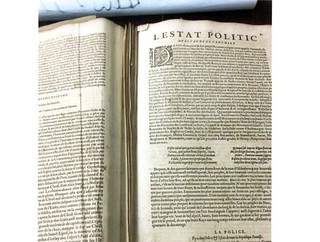 "The sentencing of John Schulman (and likewise his criminal partner Greg Priore) to home confinement and $55,000 in restitution for an ongoing $8M theft is a disgrace. They should be doing 10-15 years in prison. Everyone in the rare book field familiar with the case knows that Schulman is [lying]."
"The sentencing of John Schulman (and likewise his criminal partner Greg Priore) to home confinement and $55,000 in restitution for an ongoing $8M theft is a disgrace. They should be doing 10-15 years in prison. Everyone in the rare book field familiar with the case knows that Schulman is [lying]."
Stay tuned on this one. As noted last week, the prosecutor has asked the judge to reconsider the sentences. -Editor
To read the earlier E-Sylum article, see:
CARNEGIE LIBRARY RARE BOOK THEFT SENTENCES
(https://www.coinbooks.org/v23/esylum_v23n26a30.html)
More on Howard Daniel's Southeast Asia Countermark
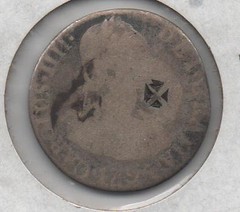 Regarding Howard Daniel's countermarked coin,
Chip Howell writes:
Regarding Howard Daniel's countermarked coin,
Chip Howell writes:
"At the risk of telling you something you already know, this is presumably Charles IV of Spain. The best matches I could spot (not knowing size/weight of coin) are 2 reales pieces from Peru or Mexico, both still Spanish possessions in the 1790s."
Thanks. Howard is still looking for an identification of the countermark, though. Can anyone help? -Editor
To read the earlier E-Sylum article, see:
NOTES FROM E-SYLUM READERS: JUNE 28, 2020 : Query: Southeast Asia Countermark Identification Sought
(https://www.coinbooks.org/v23/esylum_v23n26a13.html)
Bowers and Ruddy Star in "Night of the Comet"
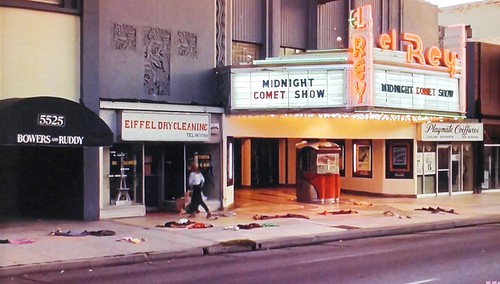
Dave Lange writes:
"With so little new programming on TV this year I've taken to recording older shows and movies for the evening's entertainment. One movie I remember seeing at a theater when new is Night of the Comet, so I watched it again this week on TV. It's set in and near Los Angeles, and in one scene I saw a brief flash of a very familiar name. Right next to a movie theater in Hollywood was the office of Bowers & Ruddy Galleries! The movie was released in 1984, so it was most likely shot a year or two earlier. It was around that same time that the newly renamed Bowers & Merena Galleries was established in New Hampshire, so the LA location was likely vacant already when the scene was filmed."
Dave included the above screen shot, so now we get to see the scene Dave Bowers mentioned in April. Thanks! We'll have to watch the full film to see the Valley Girls fighting cannibal zombies. The film was a big influence for "Buffy the Vampire Slayer". -Editor
To read the earlier E-Sylum article, see:
NOTES FROM E-SYLUM READERS: APRIL 5, 2020 : Bowers and Ruddy Galleries on Screen
(https://www.coinbooks.org/v23/esylum_v23n14a17.html)
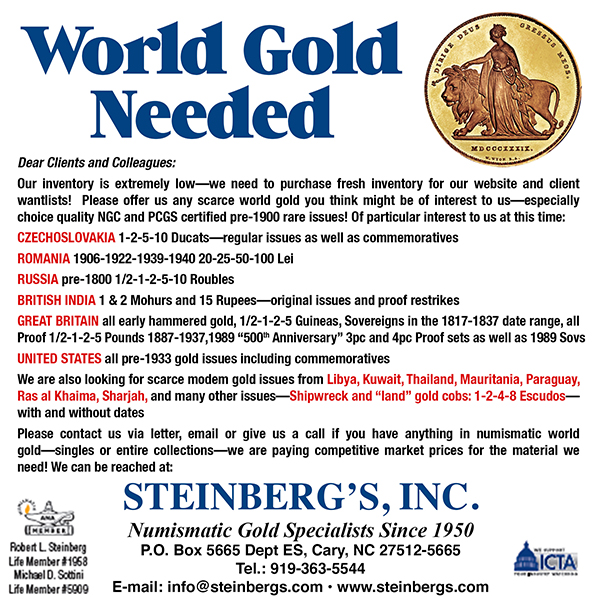
QUERY: AYLESBURY ABOLITION OF SLAVERY TOKEN
David Pickup submitted this question about an interesting token. -Editor
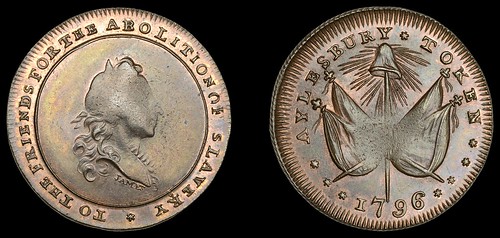
Image by kind permission of © Dix Noonan Webb auctioneers
The recent discussion about removing statues associated with slavery reminded me of a token dated 1796 which features the anti-slavery movement. The token is inscribed 'TO THE FRIENDS FOR THE ABOLITION OF SLAVERY' and on the reverse 'AYLESBURY TOKEN'. Trading slaves was not made illegal in Britain until 1807 and slavery was not finally outlawed in the British Empire until 1834.
An anti-slavery group was set up in Aylesbury in 1792 by the town vicar, one Thomas Lloyd. The anti-slavery movement in this country was dominated by evangelical Anglicans and Quakers. The reference to “friends” on the token may refer them. The token is dated after Rev Lloyd left Aylesbury but the group he started may have continued. An anti-slavery society was formed in Aylesbury in 1826 by George Nugent Grenville, MP for Aylesbury and local church ministers.
The token is a bit of a mystery.
Why do all of the examples have weakness in centre on both sides? Was it made using old dies?
The cap of liberty on a pole was a symbol used in the French Revolution. Is it a reference to the French Revolution or liberty in general?
The other side has a portrait of William III who reigned one hundred years before. There has been a Jacobite assassination attempt in 1696. Although William III was an investor in a slave owning company he was a representative of the Glorious Revolution which links to the idea of liberty. Did the issuer associate the anti-slavery movement as a revolution?
Who is the “James” underneath the portrait? Was there a designer of that name or does it mistakenly refer to King James II?
Interesting piece. Can anyone help? -Editor

VOCABULARY TERMS: FIREGILDING, FIREGILT
Dick Johnson submitted this entry from his Encyclopedia of Coin and Medal Terminology. Thanks! I'd never heard of these terms. Interesting history. Can anyone send us images of firegilt pieces? -Editor
Firegilding, Firegilt. An early form of goldplating where a mixture of gold and mercury is applied to the surface to be plated, then the object is heated to drive off the mercury. Firesilvering can be done in a similar manner as well. However, the mercury fumes given off during the heating process were so injurious to the workers the process was abandoned – even prohibited in many countries, including France where it was widely practiced. The process, developed in antiquity, was completely replaced by electroplating in the middle of the 19th century.
Medals, as well as many metal objects, were gilded by such a method beginning in the Renaissance and continuing for over 400 years. Also a form of firegilding was practiced in the orient, and some 400 year-old Japanese firegilding still exists today with the original gold intact.
Firegilding procedure. Gold and mercury are mixed together to form an amalgam – a soft waxy state where the crystals can be crushed between the fingers with a cracking sound. The amalgam is made in advance in small balls, and kept under water for short periods. The amalgam is spread on a stone – gilding stone – with the fingers. A fine brass wire brush is dipped into a solution of nitrate of bioxide of mercury until it turns white; it is then brushed over the amalgam on the stone, a portion of the gold and mercury mixture adheres to each brass bristle of the brush.
The object to be gilded, well cleaned and degreased, is then scratch brushed in every direction. The brush is repeatedly dipped in the mercury solution, brushed over the gilding stone and continued to be employed to spread the amalgam evenly over the object. Great skill was required to apply the coating evenly and on all the surfaces desired to be gilded. For objects intended to be parcel-gilt – to be gold coated only on a portion of the total piece – the area to be left uncoated was Stoped off. A mask or jig was used to cover this area while the exposed area was scratch brushed with the mercury-gold amalgam. But in most instances it was left to the skill of the craftsman to treat only the area desired.
When uniformly covered with the mercury-gold amalgam the object was then laid on a cast iron plate and heated. In later years a screen separated the operator from the fumes which were drawn off to escape up the chimney. It was these fumes – it was learned – that gave mercury poisoning to workers who practiced firegilding over a period of years. Unfortunately, many lives were shortened from the hazards of this process.
Electroplating replaced firegilding. The ease of electroplating an object with the use of gold or silver anodes and primitive batteries replaced firegilding. After having been developed in Germany in 1837, improved in England in 1838, electroplating was brought to America first by the silverware industry in 1839 (and widely increased after 1883 with commercial electricity) – effectively ending the need of firegilding. This also ended the mercury poisoning of workers by this process as well.
Firegilding in America. A small amount of items were firegilded in America. Scovill used this method perhaps as early as 1820. Other metalworking firms had brief use for the process. Scovill converted from firegilding entirely to electroplating in 1844 and was able to do gold, silver, copper and zinc plating with primitive batteries from this time onwards and used commercial electricity when this became available in late 1880s.
Cataloging firegilt specimens. Recognizing firegilding on numismatic pieces is not that difficult, and it should be mentioned in the description of the piece. If a nongold piece has some gold covering and is dated prior to 1840 it is probably firegilt (although it could have been goldplated at any time afterwards).
Firegilding looks old with some uneven darkened areas; often the edges of a parcel-gilt area are feathered. The gilding is usually very thin and some high points may have the firegilt worn off. While the gold color may be uniform, it is usually uneven with weak areas.
Reference:
P1 {1878} Spon, p 202-203.
M3 {1952} Marburg, p xxx (firegilding employed by Scovill).
F6 {1976} Lins and Oddy.
Looking for the meaning of a numismatic word, or the description of a term? Try the Newman Numismatic Portal's Numismatic Dictionary at: https://nnp.wustl.edu/library/dictionary
Or if you would like a printed copy of the complete Encyclopedia, it is available. There are 1,854 terms, on 678 pages, in The Encyclopedia of Coin and Medal Technology. Even running two a week would require more than 19 years to publish them all. If you would like an advance draft of this vital reference work it may be obtained from the author for your check of $50 sent postpaid. Dick Johnson, 139 Thompson Drive, Torrington, CT 06790.
THE BOOK BAZARRE
NELSON LEE SALTER (1874-1950)
Nelson Lee Salter (1874-1950), was born on June 30, 1874, son of Mr. Salter, a native of Michigan, and Alice G. Conley Salter (1851-), a native of Illinois born of Irish immigrant parents. His father died when he was a child. His mother remarried in 1886 to Charles Harris (1850-), a journalist and editor.
At age 18 years old he joined the ANA in October 1892 and is listed in List No. 21, as ANA Member No. 676.
He began as a coin, stamp and curio dealer in the 1890's and was an avid aficionado of Yosemite geology.
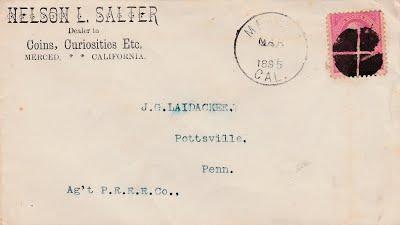
The 1900 U. S. Census lists him living at home with his parents and working as a clerk in the Merced Post Office, Merced County, California. He worked for Henry Nelson, Postmaster of Merced, California.
In 1903, he opened a general store about one mile outside of Camp Curry, Merced County, California. David A. Curry applied for an application to open a lemonade stand and it was fought by Salter claiming it would infringe on his business. Curry won the application with the restriction of only selling within his camp.
In 1910, he published a book on the geology of the Yosemite Valley, authored by Galen Clark, The Yosemite Valley, Its History, Characteristic Features, and Theories Regarding its Origin.
In 1914, he was the owner/manager of the Emerald Bay Camp, Emerald Bay, [South] Lake Tahoe, [Yosemite Valley] California.
On September 23, 1921, he married Pear B. Coffman (1889-1971), at San Francisco, California.
The 1930 U. S. Census lists him living with his wife Pearl as the owners of a hotel in Fresno, Fresno County, California.
The 1930 U. S. Census lists him living with his wife Pearl as the owners of a summer resort hotel in Fresno, Fresno County, California.
He died on April 23, 1950. He is buried at Mountain View Cemetery, Fresno, Fresno County, California.
To read the complete article, see:
SALTER, NELSON LEE
(http://www.numismaticmall.com/numismaticmall-com/salter-nelson-lee)

HARVEY STACK'S NUMISMATIC FAMILY, PART 73
The latest article in Harvey Stack's blog series is about the 1978 precious metal market and the opening of the new library wing in Colorado Springs. Thanks! -Editor
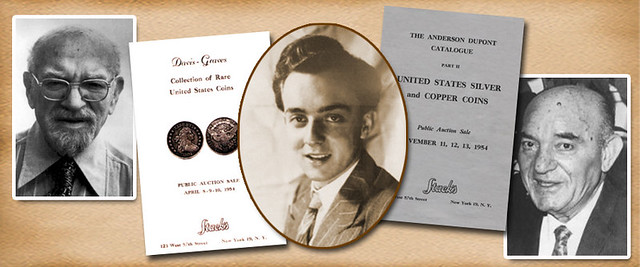
As 1978 began, inflation continued to grow as did interest in numismatics. Similar to 1977, more collectors seemed to be entering the hobby, and we saw this in increased sales of reference materials as well as growth in the number of collecting boards and other accessories being sold. Membership numbers at the American Numismatic Association were also going up. The Mint issued well over three million Proof sets in 1978, items that sold at a premium due to the special striking and packaging. This large quantity was another indication that there were many people out there collecting.
The silver precious metal markets had been growing as the Hunt family of Texas, who had made their fortune in oil, tried to get control of the silver market. As early as 1973, Bunker Hunt had bought some 35 million ounces of silver and had it shipped to vaults in Switzerland. Other Hunt family members did the same. Silver rose in value each year, and the Hunt family continued to buy as much as they could. They also placed and bought margin calls to enhance their holdings. United States silver coins became more valuable, as the premium for silver exceeded the face value of dimes, quarters and half dollars struck before 1964.
Coin dealers nationwide became resources for those who wanted to sell their silver coins at a premium in excess of face value. The rise in value for silver also brought about an increase in gold value, although it was not as actively traded. Naturally the growth of the value of precious metals had a direct effect on prices for traditional numismatic coins, which responded to the inflationary pressure.
As Stack's was focused on serving our hobby clients and very busy with that, we avoided getting too involved with the precious metal market, referring many to other dealers in New York. The Hunt family's attempt to corner the silver market eventually was unsuccessful, but for a while they were able to have a great effect.
Things got more and more active at the ANA headquarters in Colorado Springs and many numismatists started visiting. The fee that Stack's paid to the ANA for the right to run the 1976 ANA Convention auction funded the new library wing in Colorado. When the Grand Opening occurred in February 1978, Ben Stack (my partner and cousin who negotiated the 1976 auction fee) was present, as both Norman and I were suffering from a severe flu and our doctors did not want us to fly.
It really was a Grand Opening. Grover Criswell, president of ANA, Ed Rochette, executive director, the staff and many ANA members attended. The directors of the U.S. Mints at both Philadelphia and Denver were there, as were members of their staffs.
The addition to the Headquarters building was designed to house part of the library and provide a place for study material to be on display, for students and collectors to work, and to provide more space for staff. There was a plaque on the wall that stated "Dedicated to the memory of JOSEPH B. STACK & MORTON M. STACK, who through their lifetimes dedicated themselves to Numismatics and the American Numismatic Association." Their sons/nephews had wanted the Stack family's efforts honored and we were very pleased to be part of this program at the ANA.
To read the complete article, see:
Harvey Stack Remembers: Growing up in a Numismatic Family, Part 73
(https://www.stacksbowers.com/News/Pages/Blogs.aspx?ArticleID=Harvey-Stack-Remembers-Part-73)
To read the earlier E-Sylum article, see:
HARVEY STACK'S NUMISMATIC FAMILY, PART 72
(https://www.coinbooks.org/v23/esylum_v23n25a18.html)
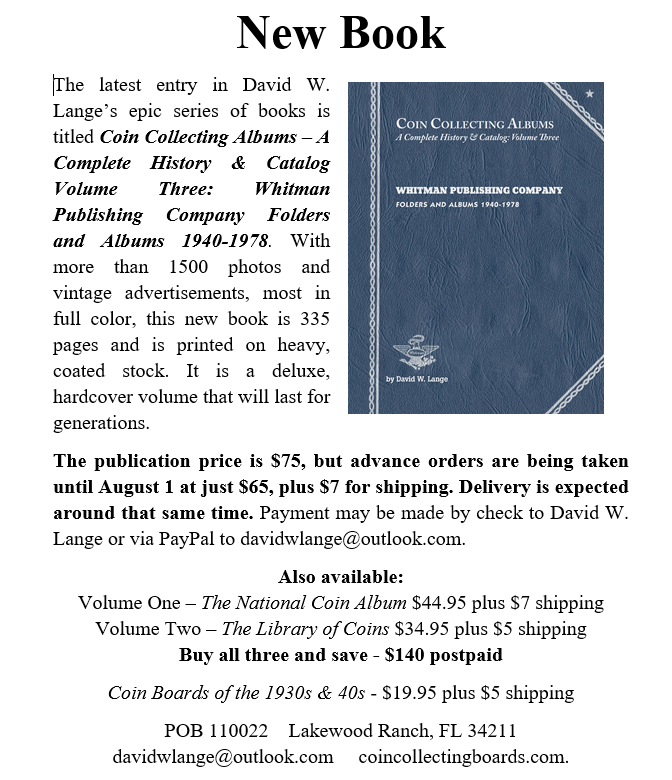
U.S. COIN DESIGNS: YESTERDAY, TODAY, TOMORROW??
This June 2020 ANA blog post by Mitch Sanders is timely; it discusses how the designs on our coins have evolved over the centuries. -Editor
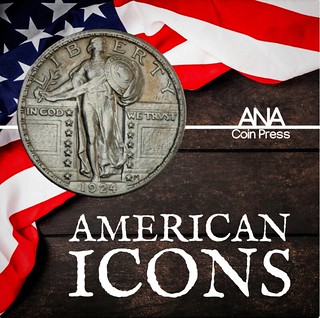 It happened so gradually that it may not be immediately noticeable, but today’s American coin designs are symbolically quite different from their predecessors. It used to be a good bet that a circulating coin would have a portrayal of Liberty on the obverse, and a rendering of an eagle on the reverse. But these days, allegories of Liberty and images of eagles are much more likely to be found on coins made for collectors – one more step in the continued evolution of these two numismatic icons.
It happened so gradually that it may not be immediately noticeable, but today’s American coin designs are symbolically quite different from their predecessors. It used to be a good bet that a circulating coin would have a portrayal of Liberty on the obverse, and a rendering of an eagle on the reverse. But these days, allegories of Liberty and images of eagles are much more likely to be found on coins made for collectors – one more step in the continued evolution of these two numismatic icons.
Liberty’s place on American money dates back to the establishment of the U.S. Mint in 1792. Things could have turned out very differently, though, because an early proposal would have placed portraits of the current President on American coins. After significant legislative debate, with expressions of concern for what some considered a monarchical practice, Liberty was chosen as a more appropriate symbol for the new nation. Each American coin was required to carry an emblematic image of Liberty, along with the word LIBERTY.
For the next century and a half, nearly all U.S. coins featured allegorical representations of Liberty. Most portrayed a portrait bust of a female figure, with variations in features and hairstyle. She is sometimes seen with a liberty cap—an ancient symbol of emancipation—or wearing an Indian headdress. Images of a seated Liberty dominated 19th-century silver coinage.
Beginning in the early 20th century, Liberty was depicted in a wider variety of poses and guises. She holds a shield and an olive branch on the Standing Liberty quarter, walks with the rising sun while draped in a flag on the Walking Liberty half dollar, and strides forward bearing a torch and an olive branch on the Saint-Gaudens double eagle ($20). She wears a spiked crown on the Peace dollar and a winged cap— representing freedom of thought—on the Winged Head Liberty dime (also known as the “Mercury” dime). These classic designs are widely considered to be among America’s finest examples of numismatic art.
But over the course of the last century, allegorical images of Liberty on circulating coins have been replaced by portraits of historical Americans. In the 21st century only the Statue of Liberty, on the reverse of Presidential dollars, has represented her allegorical predecessors.
To read the complete article, see:
AMERICAN ICONS
(https://blog.money.org/coin-collecting/american-icons)
On a more contemporary note, Ron Guth published a related piece on his Numismatic Detective Agency blog this week; here's a lengthy excerpt. Are America's Classic Coin Designs Endangered? -Editor
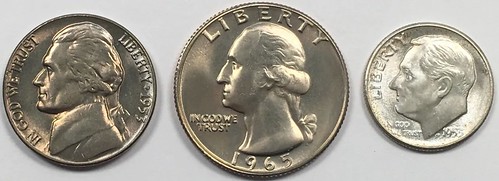
In recent weeks, political activists have vandalized or destroyed historical American statues and monuments and have called for the destruction of many more. It seems that any offense, even an insignificant one, now justifies cancelling from history anyone who, for example, fought in the Confederacy, owned slaves, fought against indigenous Americans, made a racist expression or a politically incorrect statement. I’m not here to defend any bad actors or to minimize past injustices, but to warn the numismatic community that we could be next.
What does this have to do with coins? Well, some of the “bad actors” that have been targeted by activists include numismatic favorites such as George Washington and Thomas Jefferson (slave-owners), Ulysses S. Grant (acts against native Americans), Christopher Columbus (genocide of native Americans following his “discovery” of America), and even the great Emancipator, Abraham Lincoln (racist comments). If you think it can’t happen, look at what atheists and state/religion separatists have already tried to do with the motto “In God We Trust” on American coins.
What will happen when political activists discover that the coins in their pockets memorialize their targets? If any offense justifies the removal of historical figures, there are a host of American coins that could be subject to “cancellation.”
What would cancellation look like? First, would be the removal of objectionable portraits from existing coins and paper money. Second, would be the banning of trading in such coins. Third, would be the removal from circulation and destruction of any offending coins.
Here are just a few coins that are subject to cancellation and why:
1792 “Martha Washington” Half Disme. The nickname alone justifies its cancellation because Martha was a slave-owner and married to one.
1859-1909 “Indian Head” Cent. The offense of this designer was to culturally appropriate a Native American headdress and, according to legend, place it on the head of his white daughter.
1909-Date Lincoln Head Cent. Even though Lincoln freed the slaves, many of his comments concerning them were downright racist.
1892-1893 Columbian Exposition Commemorative Half Dollar. The impact of Columbus’ discovery of the Americas is characterized as one of genocide and subjugation.
1893 Columbian Exposition Commemorative Quarter Dollar. Guilt by association – Queen Isabella funded Christopher Columbus’ trips of exploration.
1938-Date Jefferson Nickel. Slave-owner.
1913-1938 “Buffalo Nickel. More cultural appropriation.
1946-Date Roosevelt Dime. Franklin Roosevelt put Japanese-Americans in internment camps.
1932-Date Washington Quarter Dollar. Slave-owner.
1922 Ulysses S. Grant Commemorative Half Dollar. Subjugation of the Plains “Indians.”
1925 Stone Mountain Commemorative Half Dollar. Depicts Confederate Generals Robert E. Lee and Stonewall Jackson.
Arguments for cancellation could be made for many more American coins, especially among the Commemorative series. Taken to the extreme, just about any American coin could be considered offensive. Republicans could be offended that the Kennedy Half Dollar favored a Democrat. Women could be offended by the various depictions of Miss Liberty, especially those by male engravers. Animal rights activists could be offended by the various anthropomorphic depictions of eagles with scrolls in their beaks or olive branches in their talons. Peace activists could be offended by eagles with arrows in their talons or Civil War Tokens depicting elements of war.
Circulating coins, like statues, are out there in the public domain daily. Anything touching the public at large is liable to get swept up in politics at one point or another. George Washington's position of NOT wanting his portrait on our nation's first coins was itself a political statement - a defiance of the institution of monarchy he'd led a war against.
Yet times change. People DO want to honor their heroes, even reluctant ones. And one by one generic representations of Liberty have yielded to portraits of former leaders, even Washington himself.
And times may well change our change again. We see the political tug-of-war over a new portrait for the $20 bill, and we may well see calls for a new generation of heroes on our coins.
Destroying or banning the trading in newly offensive coins is quite unlikely I think, but coins can get caught up in general bans such as those on Nazi imagery, and it's already illegal to sell Medals of Honor in the U.S.
Some commentators marveled at the indiscriminate nature of the recent rioting. "When mobs tore down a statue of Ulysses S. Grant and defaced a monument to African-American veterans of the Civil War, many people wondered whether the protesters had ever learned anything in high school or college. Did any of these iconoclasts know the difference between Grant and Robert E. Lee? " (From National Review.
As Ron notes, the beef with Grant may be over his defeat of native americans rather than his defeat of Robert E. Lee, the Confederacy, and slavery. Those of us with knowledge and experience in numismatics need to be voices of reason in the discussion to prevent any unnecessary overreach. But we should also be open to discussing proposed design changes. -Editor
To read the complete article, see:
First They Came For The Statues...
(https://numismaticdetectives.com/blog/f/first-they-came-for-the-statues)
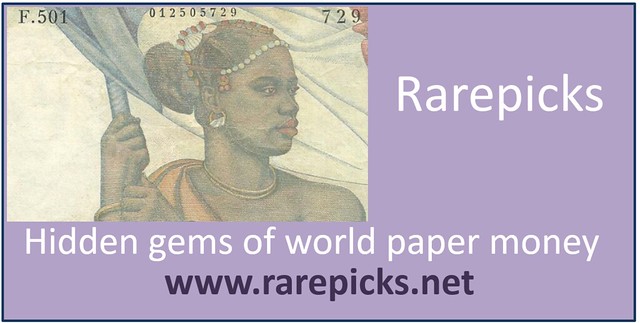
2020 AMERICAN INNOVATION DOLLAR COIN DESIGNS
Here are some of today's U.S. coin designs. This is the press release for the Mint's 2020 American Innovation dollar coin designs. The Massachusetts telephone design is my favorite. -Editor
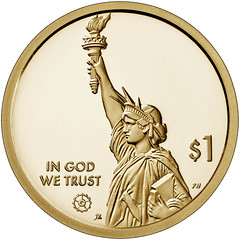 The United States Mint (Mint) today officially announced the designs for the 2020 American Innovation™ $1 Coin Program. The new designs will appear on the reverses (tails) of $1 coins honoring innovations and/or innovators from Connecticut, Massachusetts, Maryland, and South Carolina.
The United States Mint (Mint) today officially announced the designs for the 2020 American Innovation™ $1 Coin Program. The new designs will appear on the reverses (tails) of $1 coins honoring innovations and/or innovators from Connecticut, Massachusetts, Maryland, and South Carolina.
Mint Chief Engraver Joseph Menna created and sculpted the Maryland American Innovation $1 Coin design. Mint Artistic Infusion Program artists created the designs for the remaining 2020 American Innovation $1 Coins, which Mint Medallic Artists sculpted. Here’s what the public can expect to see:
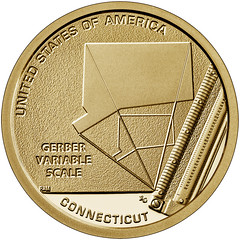 American Innovation – Connecticut
American Innovation – Connecticut
Designer: Richard Masters
Sculptor-Engraver: Renata Gordon
The Connecticut $1 Coin recognizes the Gerber Variable Scale. The design depicts the scale being used to increase a geometric shape by 200 percent, a shape that resembles the state of Connecticut. Inscriptions are “UNITED STATES OF AMERICA,” “GERBER VARIABLE SCALE,” and “CONNECTICUT.”
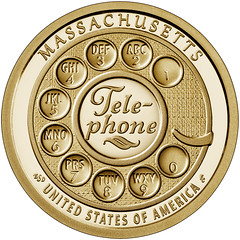 American Innovation – Massachusetts
American Innovation – Massachusetts
Designer: Emily Damstra
Sculptor-Engraver: Eric David Custer
The Massachusetts $1 Coin recognizes the invention of the telephone. The design depicts the dial of an early rotary telephone. Inscriptions are “MASSACHUSETTS,” “TELE-PHONE,” and “UNITED STATES OF AMERICA.”
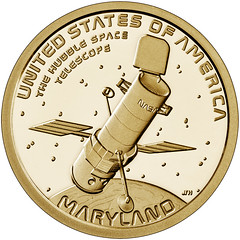 American Innovation – Maryland
American Innovation – Maryland
Designer: Joseph Menna
Sculptor-Engraver: Joseph Menna
The Maryland $1 Coin pays homage to the Hubble Space Telescope. The design depicts the telescope orbiting the earth surrounded by a field of stars. Inscriptions are “UNITED STATES OF AMERICA,” “THE HUBBLE SPACE TELESCOPE,” and “MARYLAND.”
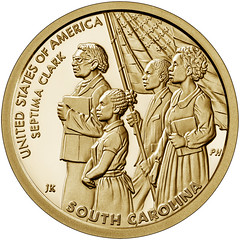 American Innovation – South Carolina
American Innovation – South Carolina
Designer: Justin Kunz
Sculptor-Engraver: Phebe Hemphill
The South Carolina $1 Coin recognizes educator and civil rights activist Septima Poinsette Clark. The design depicts Ms. Clark marching with three young African American students who carry books and an American flag, representing that education and literacy among oppressed people are necessary for empowerment and enjoyment of civil rights. Inscriptions are “UNITED STATES OF AMERICA,” “SEPTIMA CLARK,” and “SOUTH CAROLINA.”
Images are available at https://www.usmint.gov/news/image-library/american-innovation-dollar .
American Innovation $1 Coins feature a common obverse (heads) design depicting a dramatic representation of the Statue of Liberty and the required inscriptions “$1” and “IN GOD WE TRUST.”
On-sale dates for products containing the 2020 American Innovation $1 Coins will be published on the Mint’s Product Schedule here. When available, the Mint will accept orders at catalog.usmint.gov/. Information about shipping options is available at catalog.usmint.gov/customer-service/shipping.html.
The American Innovation $1 Coin Program is a multi-year series featuring distinctive reverse designs that pay homage to America’s ingenuity and celebrate the pioneering efforts of individuals or groups from all 50 states, the District of Columbia, and the U.S. territories.
To read the complete article, see:
United States Mint Announces 2020 American Innovation™ $1 Coin Program Designs
(https://www.usmint.gov/news/press-releases/united-states-mint-announces-2020-american-innovation-1-coin-program-designs)
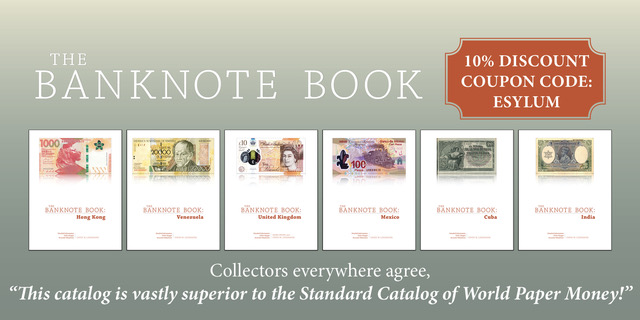
NUMISMATIC NUGGETS: JULY 5, 2020
Here's a selection of interesting or unusual items I came across in the marketplace this week. Tell us what you think of some of these. -Editor
Dialogues upon the Usefulness of Ancient Medals
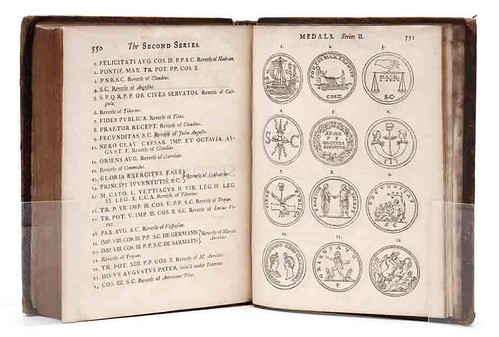
The Works of the Right Honorable Joseph Addison, Esq., in Four Volumes
(London: Jacob Tonson, 1721), quarto (10 in.), period tooled calf, spines with gilt embellishment and raised bands, engraved frontispiece portrait of Addison. Included are poems, travelogues, articles from The Tatler and The Spectator magazines, plus a lengthy illustrated numismatic essay, Dialogues upon the Usefulness of Ancient Medals.
A very nice a 299 year-old set. -Editor
To read the complete lot description, see:
Lot 96: The Works of the Right Honorable Joseph Addison, Esq., in Four Volumes
(https://www.invaluable.com/auction-lot/i-The-Works-of-the-Right-Honorable-Joseph-Addiso-96-c-8204DA6AFC)
Paulin de Lavergne Bacteriology Medal
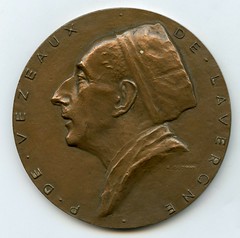
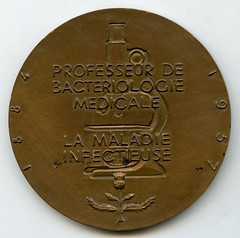
France Bronze Medicine Medal Paulin de Lavergne Professor of Bacteriology
I came across this French medal on eBay. Great portrait. -Editor
To read the complete lot description, see:
France Bronze Medicine Medal Paulin de Lavergne Professor of Bacteriology
(https://www.ebay.com/itm/France-Bronze-Medicine-Medal-Paulin-de-Lavergne-Professor-of-Bacteriology/373093189607)
1803 Large Cent
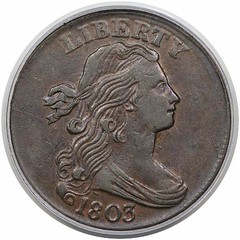
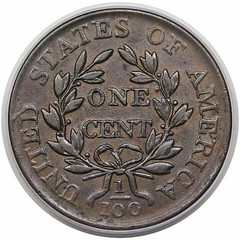
Sheldon-258 variety, considered to be Rarity-1.
Another superb early copper on our list, this is a totally original, well made, chocolate brown example of a type that isn’t so easy to find as such.
Here's an attractive coin from the stock of John and MaryAnn Agre's Coin Rarities Online. -Editor
To read the complete item description, see:
1803 Draped Bust 1¢
S-258, Rarity-1
(https://www.coinraritiesonline.com/product/1803-draped-bust-1%c2%a2/)
1913-S Lincoln Cent
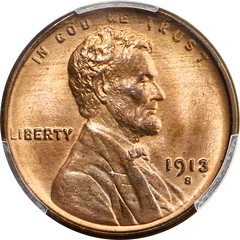
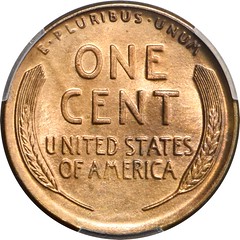
The 1913-S is a significant strike and condition rarity, rarely found in grades above MS-64. It boasts a relatively low mintage of 6.1 million coins, falling well short of the 76 million struck in Philadelphia the same year. Delightful to examine in-hand, the present specimen is tied with the finest graded by PCGS and CAC in the RB category and is an irresistible offering for the advanced PCGS Registry Set participant.
We don't often discuss coin pricing or condition, but this is one great coin being offered at Stack's Bowers. -Editor
To read the complete lot description, see:
1913-S Lincoln Cent. MS-66 RB (PCGS). CAC.
(https://www.stacksbowers.com/pages/lotinfo.aspx?LotId=1445196)

GOLD AUREUS OF SEPTIMIUS SEVERUS
The Heritage Auctions press release describes a rare Roman Aureus. -Editor
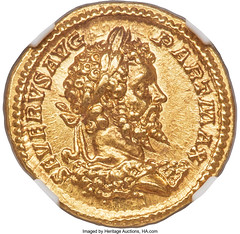
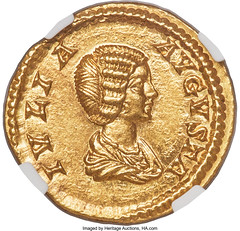
Ancient Gold Coin Survives The Year of Five Emperors and At Least 1,800 Years In Virtually Perfect Condition
Ancient Greek and Roman coins are intriguing to even those who would not call themselves a numismatist. Heritage Auctions will be offering a particularly special Roman Aureus in the ANA World Coin Auction #3085. This is a gold coin minted between 193 and 211 AD under the ruler Septimius Severus.
Despite being over 1,800 years old, this aureus survived in virtually perfect condition. This piece received top marks from NGC grading service, who assigned it a Choice Mint State Grade with 5 out of 5 for both Strike and Surface, as well as the Fine Style designation for artistic quality.
This beautiful coin may not show any signs of strain, but Septimius Severus did not exactly have a smooth transition as he came to power. The coin's beautiful surfaces do not reveal the drama of his early days in power. He seized power after the death of Emperor Pertinax in 193 AD during the famous "Year of Five Emperors"--a time when five men claimed the title of Roman Emperor during the same year and battled it out during a period of civil war.
Severus killed one of his rivals, Didius Julianus, and was declared ruler by the Senate. The unrest did not end there, however--Septimius Severus still had to deal with another claimant to the throne, Pescennius Niger. He allied with another suspected rival, Clodius Albinus, to fight against Niger and retain power.
Out of this chaos, Septimius Severus eventually emerged as successful. He then went on to have a fairly long period in power, ending with his death in 211 AD. During this time, he produced many coins including the especially beautiful gold Aureus that is up for bid here.
Given this coin's quality, it would not just be appealing to devoted collectors of ancient Roman coins. This sort of museum-quality piece survived in such beautiful condition that it would be appealing to collectors who simply seek out the very best pieces or who are students of history. Check it out here:
https://coins.ha.com/itm/ancients/roman-imperial/septimius-severus-ad-193-211-av-aureus-20mm-734-gm-6h-ngc-choice-ms-5-5-5-5-fine-style/p/3085-95006.s

GOLD COIN MAKING IN 10TH CENTURY MALI
Atlas Obscura published this piece about coin-making in 10th century Mali. -Editor
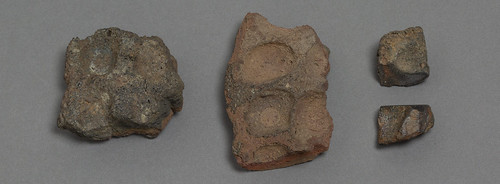
WHEN SAM NIXON, AN ARCHAEOLOGIST with the British Museum, excavated ancient coin molds in Tadmekka, Mali, in 2005, it triggered a several-year exploration of how medieval Africans purified the gold they were using for their currency. Nixon had found little droplets of highly refined gold left over in the molds—which have been dated to the 11th century—as well as curious fragments of glass. Now scientists have recreated the advanced process behind the purification method they used then.
“This is the first time in the archaeological record that we saw glass being used to be able to refine gold,” says Marc Walton, codirector of the Center for Scientific Studies in the Arts, a collaboration between Northwestern University and the Art Institute of Chicago. “The glass appeared to be material that was [actually] recycled glass materials … so it really shows the industriousness and creativity of the craftsmen, who understood the properties of gold and glass enough to [use them for] this process of refining gold.” The recycled glass materials were remnants of broken vessels. Tadmekka was a town right in the middle of the trans-Saharan caravan route, so Nixon uncovered several types of material culture that had to do with trade, namely molds for “bald dinar,” or coins that hadn’t been stamped with the name of a mint (or a 10th-century equivalent of one).
According to Walton, Europeans in the 10th and 11th centuries purified their gold through cupellation, a process in which lead is mixed with gold laced with impurities, and then heated in a furnace until the droplets of purer gold can be skimmed off. But in the case of medieval West Africans, “They were taking the ore and other raw materials from the river and mixing it with glass,” says Walton. Since gold is inert, it doesn’t fully dissolve into melted glass, while impurities and other materials do, making this “a really novel way of using recycled glass material.”
To read the complete article, see:
Medieval Africans Had a Unique Process for Purifying Gold With Glass
(https://www.atlasobscura.com/articles/medieval-african-gold)
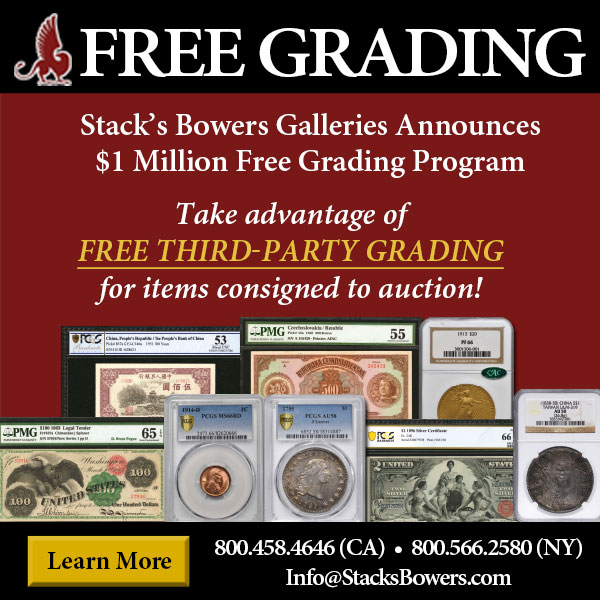
RARE SILVER PENNY OF A YORKSHIRE BARON
A metal detectorist discovered a rare silver penny issued by an obscure medieval Yorkshire Baron. Found via The Explorator newsletter. To subscribe to Explorator, send a blank email message to: explorator+subscribe@groups.io. -Editor
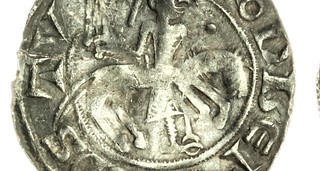 A rare silver penny found in a field dating to 1150 and made out to a local Yorkshire baron rather than King John is due to be auctioned.
A rare silver penny found in a field dating to 1150 and made out to a local Yorkshire baron rather than King John is due to be auctioned.
The coin, unearthed by a metal detectorist, is from a forgotten period of British history known as 'the Anarchy', during in-fighting between the grandchildren of William the Conqueror.
It was discovered in a Yorkshire field on March 12, dating from around AD 1148 to 1152 when a civil war raged over the right to rule England.
During this time of turmoil, a brief window in crown authority allowed local noblemen to start issuing coins in their own likeness, rather than the king.
As a result of this time of chaos, the coin was minted depicting an obscure Yorkshire Baron rather than the ruling King Stephen.
The coin shows a medieval knight on horseback brandishing a sword and is attributed to the obscure Baron Robert de Stuteville who was present at the ‘Battle of the Standard’, one of the more famous skirmishes at Cowton Moor near Northallerton on August 22, 1138.
Experts said the discovery is the first new find of its type to be documented in over 100 years and expect the coin to sell for at least £6,000.
Gregory Edmund, auctioneer for Spink and Son, said it was an "understatement" to just describe this coin as rare.
To read the complete article, see:
Rare silver coin depicting obscure Yorkshire baron which was found in a field to go under the hammer
(https://www.yorkshirepost.co.uk/heritage-and-retro/heritage/rare-silver-coin-depicting-obscure-yorkshire-baron-which-was-found-field-go-under-hammer-2899490)
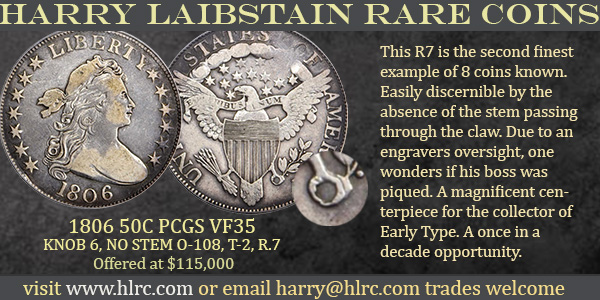
PERATROVICH DOLLARS RELEASED IN ALASKA
As discussed in earlier issues, coin collectors in Alaska lobbied the government to distribute the new Elizabeth Peratrovich dollar coins in that state. It worked - here's an excerpt from an article in the Juneau Empire. Now local banks are being encouraged to order the coins. -Editor
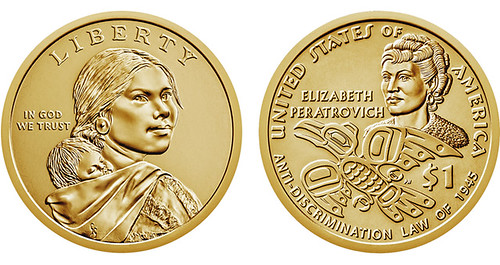
The U.S. Mint has designed a special program to sell the Peratrovich coins to Alaska financial institutions. The program makes the coins available to financial institutions in rolls of 25, bags of 100 and boxes of 250. The minimum order is four boxes of 250, and there is a daily maximum order limit of four boxes per day.
Paulette Moreno, ANS grand president, said in a phone interview she and her organization hope people who want their financial institutions to carry the coins will let their local banks know.
“It’s nice to have a symbol of something that’s so powerful and accessible to everybody,” Moreno said.
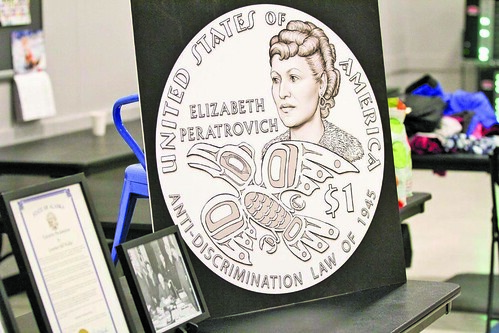
The new program is in part the result of the passage of House Joint Resolution 9 by the Alaska State Legislature. The resolution, sponsored by state Rep. DeLena Johnson, R-Palmer, requested the U.S. Secretary of Treasury not mint fewer than five million of the coins.
The resolution received widespread and bipartisan support.
Moreno worked with Alaska 4H groups to present this idea, according to an ANB and ANS news release. They received support from both ANB and ANS members, the Peratrovich family, Sealaska and others.
Moreno said she was especially proud of the initiative the 4H kids showed. She is glad the coin could become more common in Alaska.
“Elizabeth and many other Alaska Native Leaders have contributed to anti-discrimination, and the $1 gold coin is (an) opportunity to the world to show our support for equality, in all aspects of our society,” Moreno said in a news release.
Individual people are still able to purchase the coins by calling the mint’s customer care center at 1-844-467-1328.
To read the complete article, see:
Program minted to spread Peratrovich dollars
(https://www.juneauempire.com/news/program-minted-to-spread-peratrovich-dollars/)
To read the earlier E-Sylum article, see:
PERATROVICH DOLLAR MAY CIRCULATE IN ALASKA
(https://www.coinbooks.org/v23/esylum_v23n08a27.html)

SOME VERY ODD DENOMINATION TOKENS
Dick Hanscom edits the Alaskan Token Collector & Polar Numismatist. The July 2020 issue includes an interesting discussion of two rather odd denomination tokens. With permission, we're republishing it here for E-Sylum readers. The "Editor's comments" here are Dick's. -Editor
WHY A $1.20 TOKEN?
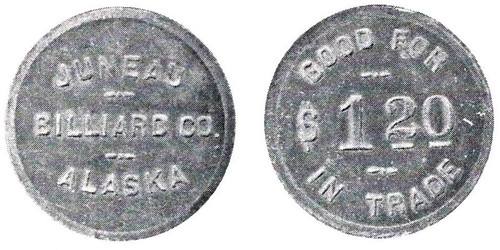
A Juneau Billiard Co. $1.20 token (B-32c) recently sold on eBay for the opening bid of $495. The question is: Why a $1.20 token?
Ron Benice reported to us that Kern Wilson of Utqiagvik (Barrow) reports on token sales on eBay for the National Token Collectors Association, and boldly stated that the $1.20 denomination indicated that it was for bottle deposits - 24 bottles at 5¢ each. But what would a billiard company be doing redeeming bottles? This started a few emails flying.
J.D. Williams suggested that we contact Kaye Dethridge as he owned a bottling company in Juneau. Further, J.D. reminisced that as a boy in Juneau in the 1950s finding six Coca-Cola bottles in a single day (=30¢). “That may not sound like much, but back in those days I could buy a double decker hard packed ice cream cone from Garnick’s Grocery in Juneau for five cents.”
Kaye Dethridge chimed in: “I’ve always figured that the $1.20 denomination was pretty strange. The deposit thing sure sounds plausible, though I wasn’t involved in that end of it so don’t have personal knowledge of it. I did buy Card’s bottling company (October 1, 1958) and bottled pop there for several years. We re-named the business Totem Beverage Co. And, yes, we did bottle the pop in stubby brown beer bottles. Every Friday morning I would make the rounds of the bars, picking up the bottles, which they saved for me. We paid the bars 15¢ a case for them. Does anyone know why the NAT&T had a $1.10 denomination token? That might give us some more insight.”
Sadly, the $1.10 token from the NAT&T Co. is a whole different story (see [below]).
But what does a billiard company do with a $1.20 token? Kern Wilson might have just hit the nail on the head.
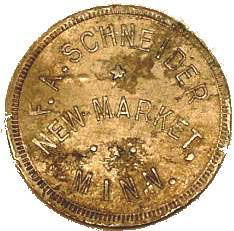
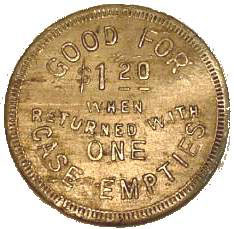
If you look on line at tokencatalog.com, and search $1.20 tokens, you find a lot (mostly from Minnesota!) that actually state that they were for bottle deposits. Legends are sometimes simple:
“Good for $1.20 with case”
to specific:
“Good for $1.20 upon return of one Hamm case & bottles”
to way too much information:
“Due the bearer, the sum of $1.20 upon the return of this check together with one empty two dozen quart case with bottles in good and serviceable condition.”
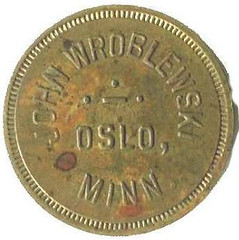
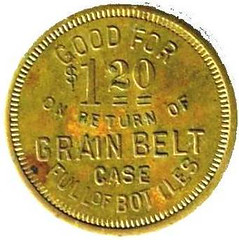
via tokencatalog.com.
Before looking at the Library of Congress newspapers, I did not realize the connection between the Juneau Liquor Company and the Juneau Billiard Company. It seems likely to me that when JLC was in the liquor business, they had to deal with empty bottles. This function probably was inherited by the JBC, but “soft drink” bottles.
While we can never really know why the $1.20 token was issued, this seems like a reasonable explanation.
Now, about the $1.10 NAT&T token...
AND WHAT ABOUT THAT $1.10 TOKEN?
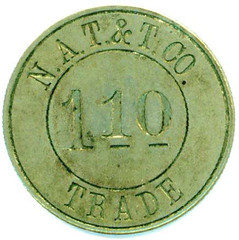
Theory 1: from Ron Benice In my research, after reading A.B. McCullough’s “Money and Exchange in Canada to 1900” I proposed the following in the April 1997 issue of ATC&PN:
“He described the mid 19th century practice among Canadian bankers, merchants and exchange dealers of using the $4.8666 exchange rate for currency transactions or minor coins but a rate of $4.444 when dealing with silver dollars or American gold coins. Interestingly, the ratio between these two rates is $1.095 which rounds quite nicely to $1.10. He didn’t say when the dual rate system was discontinued, but did hint that some old financial practices persisted longer on the western frontier than in the rest of the country. So it remains an interesting possibility that the $1.10 tokens were used as change for payments in gold or silver while the $1.00 tokens were used with paper money and minor coins.”
Editor’s comment: Keeping accounts based upon the British Pound, to which the Canadian Dollar was tied, seems a bit awkward. However, there would be an advantage to receiving silver dollars and American gold in payments if that is what your creditors were requiring.
Theory 2: from Tony Chibbaro, South Carolina token researcher. The only other $1.10 tokens on tokencatalog.com (other than drink tokens) are from South Carolina.
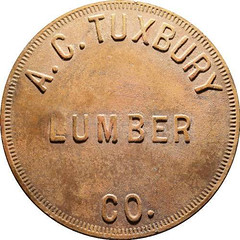
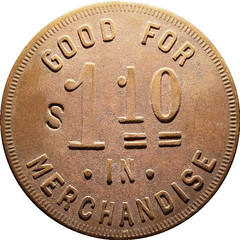
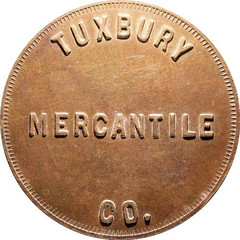
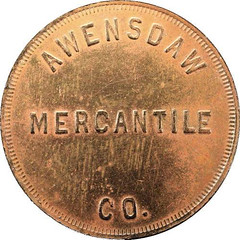
The only way that I can think of to account for the odd denomination of these tokens is to offer a discount to an employee, and in doing so making sure that your employee is not being profited upon by shopping at the store of the company that he worked for. (SC tokens compliments of Tony Chibbaro).
Editor’s comment: Tuxbury and Awensdaw Mercantile (both $1.10 tokens) were the company stores of Tuxbury Lumber Co. Company stores have a reputation of exploiting the workers. Perhaps Tuxbury was an exception!
Theory 3: from your editor
If you tendered cash, and were willing to accept tokens in change, rather than a $1 token, you would receive a $1.10 token. This allowed the merchant to conserve his cash, and gave the customer a bonus. Tokens tendered received tokens in change.
Editor’s Conclusion: Theory 1 would work for bankers, but I don’t see it applying to general commerce on the retail level. Theory 2 makes sense, allowing a worker a 10% bonus, perhaps for accepting tokens as his salary. In the North where cash was always in short supply, giving the customer a bonus for accepting tokens rather than cash would be good business practice.
Alaskan Token Collector & Polar Numismatist, published 10 times per year, is a publication of Alaska Rare Coins. Contact Dick at akcoins@mosquitonet.com for subscription rates.
I shared the articles with Dave Schenkman, who collects and studies odd denomination tokens. -Editor
Dave writes:
"The $1.10 token is quite a rare denomination. There's always a reason for the denomination, but it can be hard to know so many years after the fact."
Dave shared images of a couple of his favorites. -Editor
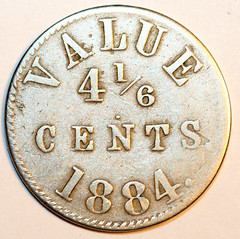
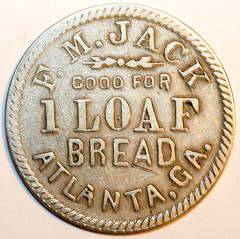
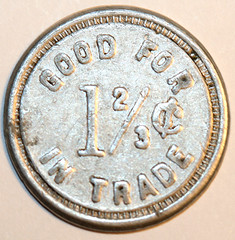
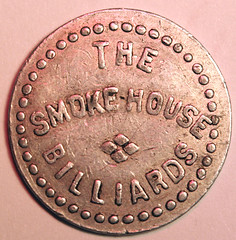
Dave adds:
"Six of the Georgia token equaled 25¢. Three of the other one equaled 5¢."

COLLECTORS SEEK 2020 TENINO WOODEN SCRIP
As I'd suggested earlier, collectors are approaching residents of Tenino, WA to purchase examples of their new coronavirus-relief wooden scrip notes. -Editor
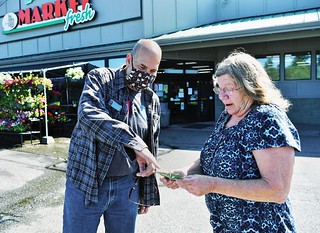 Collectors from around the world are vying to snap up Tenino’s wooden scrip — in some cases bidding up to 12 times the cedar cards’ $25 value — and the phenomenon seems to be tickling pink Tenino Mayor Wayne Fournier.
Collectors from around the world are vying to snap up Tenino’s wooden scrip — in some cases bidding up to 12 times the cedar cards’ $25 value — and the phenomenon seems to be tickling pink Tenino Mayor Wayne Fournier.
“The fact that the Tenino currency is the highest valued currency in circulation dollar for dollar in the world right now is an amazing statement,” Fournier said last week. “The program is an inspiration worldwide, and that’s pretty mind boggling.”
Moreover, he added, the program’s phenomenal publicity has prompted half a dozen donations totaling about $6,000, and other cities around the country have been contacting city hall to find out more about the grant program and how they might establish one of their own.
For longtime Tenino resident Lauretta Mahlenbrei, the simple index-sized wooden cards featuring George Washington’s face and a $25 symbol are anything but pretentious collector’s items. They’re utilitarian, plain and simple, and they have saved her bacon — and freed her from cleaning people’s toilets just to buy food for her ailing dog.
Mahlenbrei, a Tenino School District bus driver, has been out of work since March 13 when Gov. Jay Inslee ordered all state schools to close to help combat the coronavirus.
For the following 2 ½ months the 63-year-old tried to make ends meet on the $250 per week the school district continued to pay her for her regular bus route, but her typical extra trips, which could double her salary — such as driving students on field trips and sports teams to games — evaporated when the schools closed.
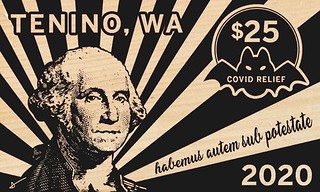 But on May 28 — after jumping through a few hoops at city hall, she said — Tenino’s COVID-19 Recovery Grant Program rescued her. On that day she received 12 wooden cards bearing Washington’s face, each marked $25. The $300 total was redeemable at a variety of businesses around town that had agreed to participate in the grant program.
But on May 28 — after jumping through a few hoops at city hall, she said — Tenino’s COVID-19 Recovery Grant Program rescued her. On that day she received 12 wooden cards bearing Washington’s face, each marked $25. The $300 total was redeemable at a variety of businesses around town that had agreed to participate in the grant program.
And then on June 10 — as her money was again set to run out — the city approved her second COVID-19 Recovery grant application, and she subsequently received another $300 scrip installment.
Mahlenbrei was, in fact, one of the first Tenino residents to qualify for the wooden scrip and is to date the only one to receive more than one grant. So far, she has used scrip to purchase merchandise or services at about five out of the 14 Tenino businesses participating in the program.
And on a sunny late-June day in front of Tenino Market Fresh, Whidbey Island resident Franc Sawatzki approached Mahlenbrei with an offer he hoped she couldn’t refuse. The 55-year-old wanted to buy three of her scrip for souvenirs — but before he could even name a price Mahlenbrei was gently refusing.
“I’d heard about the wooden dollars and wanted to buy a few to help out the small town,” he said. “I wanted one for myself and two for relatives.”
Sawatzki, clad in a National Public Radio T-shirt and surgical mask — seemed genuinely interested in the history and design of the scrip, and after chatting with Mahlenbrei for a few minutes went on his way in search of someone else willing to sell the elusive wooden currency.
Through Wednesday, June 24, the owner of Tenino Coffee Bistro had fielded at least seven telephone calls from people as far away as New York wanting to purchase Tenino wooden scrip — for as much as $300 per $25 scrip card.
Williams, who says she was “one of the very few people who tried to open a business during COVID-19,” has been operating since April 1. So far, she has had no customers offer wooden scrip to buy drink, food or other merchandise in her store — which includes white T-shirts emblazoned with images of the scrip.
But she’s received plenty of calls offering to buy the cedar cards.
To read the complete article, see:
Collectors Seek Tenino Wooden Currency
(http://www.chronline.com/community/collectors-seek-tenino-wooden-currency/article_5431973e-ba5d-11ea-b311-ab97a51bf16c.html)
Found via News & Notes from the Society of Paper Money Collectors (Volume VI, Number 2, June 30, 2020).
The town of Centralia, WA is considering its own scrip issue. -Editor
The Centralia City Council held a workshop on Tuesday evening to discuss how the city plans to utilize the $515,100 of federal COVID-19 relief funding. The council discussed the details of an application process for non-profit organizations to receive a portion of the funds and the creation of a scrips program.
The details of the scrip program were not finalized at the workshop — city staff will prepare a resolution for consideration and the city council will vote on it at their next council meeting on July 14 at 7 p.m.
City staff researched the options for a scrip program and Brodersen presented the general requirements to the council for discussion at the workshop. The city is looking to allocate $50,000 of the CARES Act funds toward the scrip program.
The scrips would only be available to Centralia residents who complete the application and meet either the income thresholds or are enrolled in the senior discount program at the City of Centralia utilities. An eligible household will receive a set amount based upon the household size with a maximum award of $250 to be spent at participating Centralia businesses.
To read the complete article, see:
Centralia Considers Creating ‘Scrip’ Program, Similar to Tenino’s Wooden Money
(http://www.chronline.com/community/centralia-considers-creating-scrip-program-similar-to-tenino-s-wooden-money/article_0182896c-bcb5-11ea-8631-1714ce22dff6.html)
To read earlier E-Sylum article, see:
TENINO'S 2020 WOODEN MONEY
(https://www.coinbooks.org/v23/esylum_v23n24a35.html)
CNN COVERS TENINO'S 2020 WOODEN MONEY
(https://www.coinbooks.org/v23/esylum_v23n25a31.html)

ON COLLECTING WOODEN MONEY
Tom Kays submitted this timely article on collecting wooden money of all sorts. Thanks! -Editor
As regular E-Sylum readers you have been subjected to frequent Nummis Nova goings-on each month in Wayne’s Numismatic Diary. No such dinners are happening for the duration. Now we have to poke and prod each other through remote telecommunications, not nearly as fun as tossing things across the dinner table. As we wait for normalcy to return, don’t go stale on coin collecting fun, even if your usual channels of socializing, sharing, and acquiring coins from fellow collectors and dealers are festering, socially isolated, virtual, and feel pretty remote.
Friend, would you consider joining the legions of Lignadenarists, for some wholesome fun and fellowship? I mean, maybe you need to add some new wood to the woodpile to float your boat and rack your stack, if you know what I mean. Like chips off the old block, fledgling lignadenarists can “get their woody on” by assembling an awesome stack of lumbar at near face value. They say don’t take any wooden nickels but don’t listen to “them.” Sure enough, wooden money is collectible and practically grows on trees…no it really does!
The International Organization of Wooden Money Collectors (IOWMC) and official ANA club, celebrates its 56th anniversary this year. They encourage the study and enjoyment of wooden nickels, as well as dimes, quarters, dollars, $5.00 and $10.00 pieces, flats, rounds, official and semi-official emissions, commons and mavericks. Of course, this obsession with wooden money first sprouted in California (the land of big trees) in 1964. From trees to forest, these early wood enthusiasts grew to host the World’s First All Wooden Money Convention in Ohio, in 1974 with over one million pieces of wooden money heaped about the convention hall in blazing displays of lignadenarist splendor. The IOWMC holds annual meetings in association with the Central States Numismatic Society Convention in April. Life membership is for the rest of your natural life as long as you abide by the by-laws and Constitution of the IOWMC. See http://www.woodenmoney.org/ to find out what behavior is straight, plumb, and level with officially-sanctioned “woodys.” I wonder what form of currency is acceptable for payment of dues?
Don’t miss out on “Bunyan’s Chips,” the official plank of the IOWMC. Volume LV, Issue 2, from February 2020 speaks to the needs of collectors and issuers of wooden money. Wooden money issues tend to only a few hundred each, making for a lifetime of new discoveries of money quite lofty on the Universal Rarity Scale. In what other field of numismatics do collectors quickly envision not just collecting, but actually designing and stamping their own scarce and collectible tokens? Be your own mint master! “A History and Checklist of Wooden Money” by Emil Di Bella is offered for sale in this edition Bunyan’s Chips to orient those who never harvested before. Buy the book before the wood, is always a wise plan.
Here for example is a flat to pass current at one shilling or a “triple-nickel” in U.S. coin, issued in commemoration of the Tercentenary Celebration of the first silver coinage of the American Colonies (1652 – 1952) by the Cheshire County Numismatic Society of Keene New Hampshire.
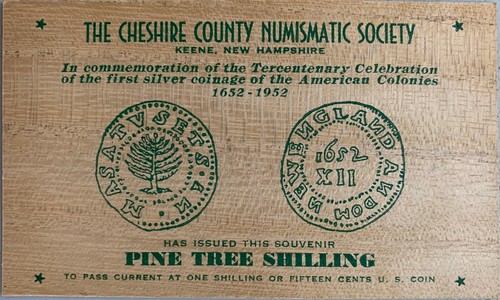
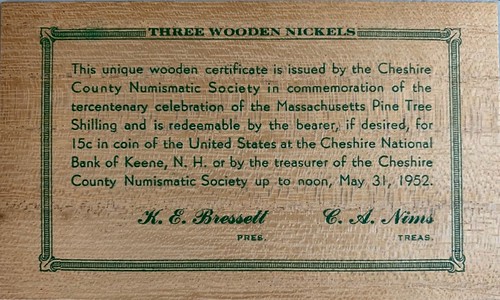
Let me ask you how numismatic terms for metallic coinage change, when applied to wooden money? I’ll bet you never had to contend with the heartbreak of shrinkage, termites, or knotholes in your cents before. One wooden dime issued by Paxton Beautiful Woods proclaims: “Paxton delivers the whole dollar…NOT JUST 90 Cents!” “No shrinkage & degrade!” Of course, they refer to equalizing kiln shrinkage, that if misapplied can warp or split wooden coins over time, but you knew that. Old wood does dry out as seen on this fragile Atlanta Coin Club 25th Anniversary Five-wooden-nickel piece from 1954.
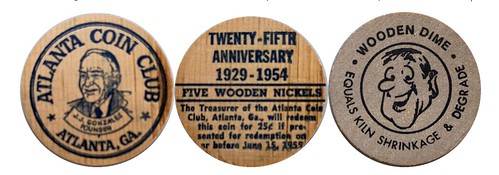
For our northern neighbors consider “Timber Talk” the official publication of the Canadian Association of Wooden Money Collectors (CAWMC). CAWMC sprouted in 1975 and features “wood of the month” for the maple leaf crowd. Woods were issued by every nook and hamlet of America in the latter 20th century, from annual county fairs to neighborhood bars. Some are denominated in cash, others in trade, and some have no redeeming qualities at all. Dealing in woods is like rediscovering the wild west with every occasion, diversion, vice/virtue, hometown establishment, roadside attraction, gotta’ have product, club event, milestone, and sometimes messages of no discernable rhyme or reason at all, conveyed in ink-stamped simplicity. Recurring themes include buffalos and native Americans, Thomas Jefferson’s bust, and the moniker “TUIT” which needs no explanation on “a round,” if you do ever get “it” going.
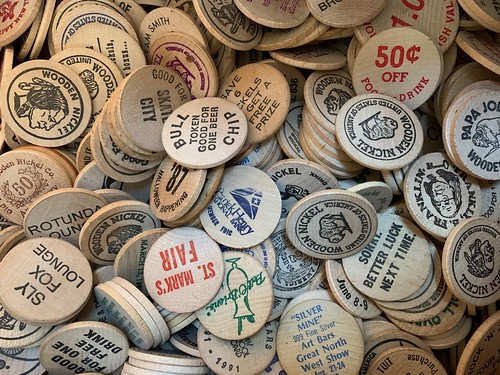
So, I bought a lot of 600 woods and find not too common examples such as the “Psychedelic Serpents” from the 1968 Mardi Gras, sponsored by the “Trumpers Karnival Krewe,” a Souvenir Wooden Dollar from the 1984 Los Angeles XXIII Olympiad with image of the Olympic commemorative silver dollar, an undated Powell Valley High School “Carmines” Home and Away Game Calendar, a Wintertown, Pennsylvania 1871 – 1971 Centennial piece with panoramic view of their Volunteer Fire Company station house and school house, no doubt highlights of civic pride and likely all there was to see in Wintertown, PA, and a 2nd Annual Beckstrom Reunion “so-called wooden dollar” from July 4 – 6, 1986, planned for York, PA, but counterstamped, “CANCELLED.” What heinous events must have happened at the 1st Beckstrom reunion in Pickerington Ohio in 1985 that they would issue tokens that specifically cancel the next family get-together? Inquiring minds want to know. These are just five out of hundreds of different examples, many needing further research to appreciate exactly what gems and woodchucks are hidden in this woodpile.

You may soon develop a theme to focus your collecting of woods if I may go out on a limb, such as coin club conventions, “Free Drink Tokens” that might work on your friends depending on what sort of friends you’ve got and how many drinks they’ve already had, or interesting personalities. As an example, consider the calling card of “Frankly, B. Franklin,” the “Witty, Wise and Wonderful!” “Featuring Burdette Parks as Benjamin Franklin [in a] Sparkling One-Man Performance.” I want to know more. These random chips are a perfect diversion that could appeal to the numismatic researcher in you too, to keep you engrossed for hours. Got time on your hands these days? Got a little (possibly very little) collector cash burning a hole in your pocket and no open brick and mortar coin shop to visit? Consider adding tinder to that acquisitive fire by buying a cord of wooden money from your friendly on-line retailer. Wooden nickels stack, roll, and flip to help you in decision-making, just like those awful ‘zincoln cents, but does your money promise you Smoke & Honey Beef Jerky with your next jar, a free draft in the Spinnaker Room of the Main Sail Restaurant, Free Skating at Round-A-Bout Skating, a free Coke while we fill your prescription at Von Pippins Drug Store, credit on TV & Appliance Repair, a free wallet size photo, or a free appetizer with purchase of any entree at Smokey’s Pub House? I think not. Let the chips lie where they fall.
For more information on the International Organization of Wooden Money Collectors, see:
http://www.woodenmoney.org/
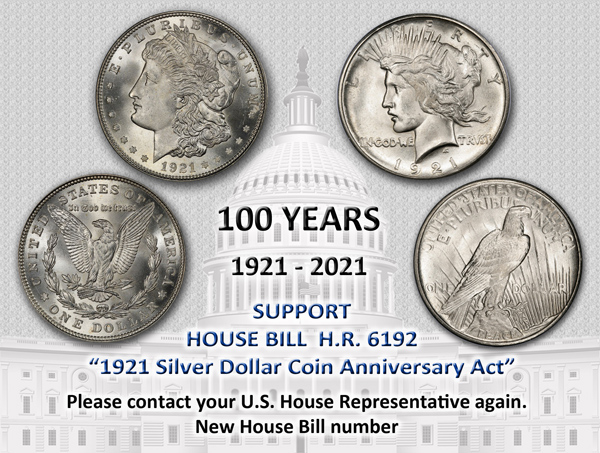
LOOSE CHANGE: JULY 5, 2020
Here are some additional items in the media this week that may be of interest. -Editor
The Randall Hoard
Dave Bowers wrote a piece for Coin Update on the famous Randall Hoard of U.S. Large Cents. -Editor
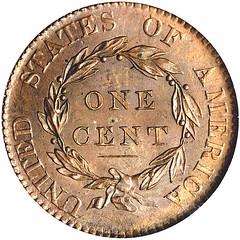 While notices about the Randall Hoard differ in some details, it seems to be the consensus that a small wooden keg (or perhaps more than one keg) filled with Uncirculated copper cents was found beneath a railroad station platform in Georgia after the Civil War, but before autumn 1869. The cents may have been hidden during the 1861-1865 war years to prevent discovery, or they may have been stored in such a railroad facility before that time, possibly as early as the late 1830s. Alternatively, the hoard may have had nothing to do with any railroad platform (as usual, hard facts are scarce). In the 1816 to 1820 period, the Philadelphia Mint reused wooden kegs that had been obtained from Boulton’s establishment in Birmingham, England, from whom the Mint bought blank planchets. These kegs typically held about 14,000 cents or cent planchets, although Mint records exist of kegs containing 12,000 to 18,000. Since the Randall Hoard coins were described as being in a small keg, quite possibly, the number was less, perhaps on the order of 5,000 to 10,000 coins.
While notices about the Randall Hoard differ in some details, it seems to be the consensus that a small wooden keg (or perhaps more than one keg) filled with Uncirculated copper cents was found beneath a railroad station platform in Georgia after the Civil War, but before autumn 1869. The cents may have been hidden during the 1861-1865 war years to prevent discovery, or they may have been stored in such a railroad facility before that time, possibly as early as the late 1830s. Alternatively, the hoard may have had nothing to do with any railroad platform (as usual, hard facts are scarce). In the 1816 to 1820 period, the Philadelphia Mint reused wooden kegs that had been obtained from Boulton’s establishment in Birmingham, England, from whom the Mint bought blank planchets. These kegs typically held about 14,000 cents or cent planchets, although Mint records exist of kegs containing 12,000 to 18,000. Since the Randall Hoard coins were described as being in a small keg, quite possibly, the number was less, perhaps on the order of 5,000 to 10,000 coins.
The typical specimen seen today with a Randall Hoard pedigree is a mixture of original bright red with flecks and stains of deep brown or black. Few, if any, are pristine (uncleaned, undipped) full mint red. According to Walter H. Breen’s research sponsored by Wayte Raymond in the 1950s, the most readily available variety attributable to the Randall Hoard is 1818 Newcomb 10, followed by 1820 N-13. Curiously, both of these varieties are usually seen with die breaks linking the stars and date.
To read the complete article, see:
Bowers on collecting: The famous Randall Hoard
(http://news.coinupdate.com/bowers-on-collecting-the-famous-randall-hoard/)
Old Coin Press No. 1 Rides Again
Old Coin Press No. 1 got fired up again for the Fourth of July weekend. -Editor
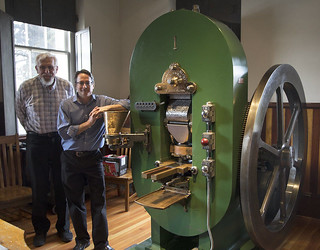 The Nevada State Museum will be firing up its original Coin Press No. 1 this Independence Day, giving visitors a chance to see Nevada coin minting history in action.
The Nevada State Museum will be firing up its original Coin Press No. 1 this Independence Day, giving visitors a chance to see Nevada coin minting history in action.
It is the first time the press, which stamped U.S. coins at the Carson City Mint between 1870 and 1893, will be operated since March. The Nevada State Museum, 600 N. Carson St., is housed in the original mint building, which closed in 1899.
“We’re glad to be able to offer this popular presentation to the public again,” Myron Freedman, Nevada State Museum director, said. “Coin Press No. 1 is a true Nevada treasure, something all Nevadans should get to see in action.”
Freedman said the coin press will be operated every Saturday from 11 a.m. until 3 p.m., as long as the museum is able to continue to remain open to the public during the COVID-19 pandemic.
Visitors to the museum can purchase a $75 .999 pure silver blank to have a commemorative medallion made during their visit.
Historic coin press to strike again
To read the complete article, see:
(https://elkodaily.com/m%20ining/historic-coin-press-to-strike-again/article_f5038898-8642-527d-b566-36f6d07a83eb.html)
Gary Gianotti Interviewed
In February Gary Gianotti submitted an article about his theory on the origin of a silver oval George Washington Indian Peace Medal. Last week he was interviewed about his theory on the 21st Century Radio program on WCBM Baltimore. -Editor
To listen on YouTube, see:
Gary Gianotti — Great Seal of the #USA , Stuart Freemasonry
(https://www.youtube.com/watch?v=aTHSEnhApi0)
To read the earlier E-Sylum article, see:
JOSEPH LOVELL WRIGHT JR: PEACE MEDAL DESIGNER?
(https://www.coinbooks.org/v23/esylum_v23n07a12.html)
Denise Rust Ponzi Scheme Plea Deal
Here's the latest update from Utah in the Rust Rare Coin precious metals scheme. -Editor
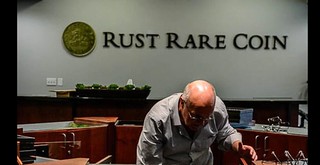 A rare-coin dealer’s wife named in an indictment for money laundering last May reached a plea agreement Thursday.
A rare-coin dealer’s wife named in an indictment for money laundering last May reached a plea agreement Thursday.
Denise Gunderson Rust, who allegedly helped her husband, Gaylen Dean Rust, run a $200 million Ponzi scheme attempting to defraud investors with a fake silver trading program, pleaded guilty to one count of money laundering, according to the U.S. attorney for Utah.
The indictment alleged that from 1996 to November 2018, Gaylen Rust conspired to defraud people by offering them stock in a silver trading program, using money from later participants to pay back the promised return to early investors. The money was never used to purchase silver, though, according to the court documents, and there was never any silver placed in depositories.
To read the complete article, see:
Wife of rare-coin dealer indicted for Ponzi scheme cuts a deal
(https://www.sltrib.com/news/2020/07/02/wife-rare-coin-dealer/)
To read the earlier E-Sylum article, see:
RUST RARE COIN ACCUSED OF PONZI SCHEME
(https://www.coinbooks.org/v21/esylum_v21n46a10.html)
The Waterloo Medal
This SPINK Insider article discusses a Waterloo Medal and other medals in the firm's upcoming July sale of Orders, Decorations and Medals. -Editor
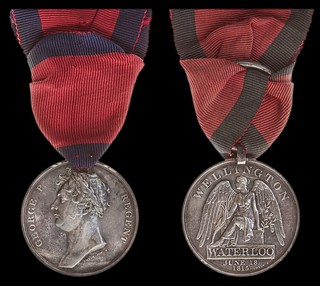 The Waterloo Medal seen here and awarded to Lieutenant-General the Hon. Sir Charles Colville represents one of only six Waterloo medals awarded to British Lieutenant-Generals. Colville had a long and distinguished military career, commencing in the West Indies in the 1790’s followed by Egypt in 1801 then the Peninsular War; he played a prominent part in the sieges of Ciudad Rodrigo and Badajoz (in January & April 1812 respectively), being wounded at the latter during the final assault.
The Waterloo Medal seen here and awarded to Lieutenant-General the Hon. Sir Charles Colville represents one of only six Waterloo medals awarded to British Lieutenant-Generals. Colville had a long and distinguished military career, commencing in the West Indies in the 1790’s followed by Egypt in 1801 then the Peninsular War; he played a prominent part in the sieges of Ciudad Rodrigo and Badajoz (in January & April 1812 respectively), being wounded at the latter during the final assault.
In later life Colville went on to become Commander-in-Chief of the Bombay Army and Governor of Mauritius before retiring to London, where he died in 1843.
To read the complete article, see:
Commemorating the Battle of Waterloo, 205 Years On
(https://insider.spink.com/2020/06/16/commemorating-the-battle-of-waterloo-205-years-on/)
Higher Prices for Engraved Gems
Engraved gems are closely related to numismatics, and highly collectible. Recently we discussed a new book on the topic. Here's an article from Antiques Trade Gazette about the current market for gems. -Editor
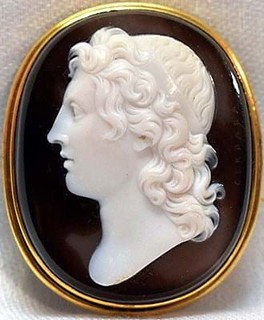
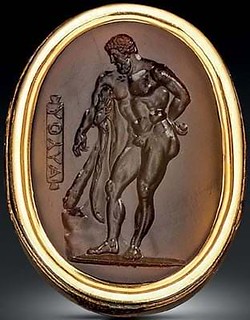
Interest in glyphic art, that reached its collecting apogee during Grand Tour collecting, is resurgent once more.
Museum and dealer exhibitions, new collectors, new literature – and a sense that the market was undervalued – have prompted a spate of strong prices at auction.
Last year, in particular, was a renaissance moment for hardstone cameos and intaglio gems. The year that began with the sale of a sardonyx cameo ring by the noted English engraver Nathaniel Marchant for £39,000 at Tennants of Leyburn in January included the re-emergence of two of the ‘lost’ Marlborough jewels – a Renaissance period sapphire intaglio carved with the bust of Julius Caesar (£62,000 at Woolley & Wallis in July) and another with the face of Mark Anthony in golden sard (£36,000 at Cheffins in December).
So far in 2020, this ‘return to form’ has continued with Far Eastern interest growing.
To read the complete article, see:
Intaglios cutting a deeper impression and making higher prices
(https://www.antiquestradegazette.com/print-edition/2020/july/2449/feature/intaglios-cutting-a-deeper-impression-and-making-higher-prices/)
To read the earlier E-Sylum article, see:
NEW BOOK: ENGRAVED GEMS AND PROPAGANDA
(https://www.coinbooks.org/v23/esylum_v23n23a03.html)

FEATURED WEB SITE: SOUTH AFRICAN COINS
This week's Featured Web Site is Scott Balson's site about South African coins, token coins & bank notes from van Riebeeck to 1932.On this web site coins and bank notes currently held by my family trust, the Balson Holdings Family Trust, like the Veld Pond, Griqua Een Pond note and German East African "siege" 15 Rupee Tabora Pound, are equated numismatically equal or lower than extraordinary and historically living trade tokens like the Strachan and Co and F C Larkan pieces - despite these tokens being worth a tiny fraction of the mainstream pieces' "investment value" at this time. (Since this web page has been established the relative investment value of these tokens has far outpaced any other traditional numismatic pieces). After 25 years of hands-on research and collecting a unique set of related books I have been fortunate to be able to re-write much of the early history of numismatics in South Africa (ie pre-1900).
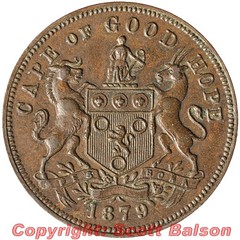
http://www.tokencoins.com/

